Build 1749
September 16, 2009
Comments
- New CommentRange setting: KeyItemsConditionString (#763)
KeyItemsConditionString is a string that evaluates to True or False. It controls whether the KeyItemsString is evaluated for any given cell within the comment range. When used, the KeyItemsConditionString is typically a formula.
Let’s say, for example, that the comment range contains blank and locked cells that are not intended to have associated comments, and therefore should not have any associated key items. To exclude these cells, the KeyItemsConditionString can be set to the following:
=Not(Or(IsBlank(@ACell()), @CellIsLocked()))
When a given cell is blank or locked, the condition evaluates to False and the KeyItemsString is not applied to the cell.
Alternatively, the same condition can be included in the KeyItemsString formula using the Excel IF function. For example, using the following, when a cell is blank or locked, the key items string evaluates to an empty string:
=If(Or(IsBlank(@ACell()), @CellIsLocked()), "", "<key items>")
In cases where many of the cells within the comment range are excluded from having comments, performance can sometimes be improved by using the KeyItemsConditionString instead of including the same condition in the KeyItemsString.
- Note that beginning with Build 1673, it is not necessary to exclude the non-origin cells within a group of merged cells using the KeyItemsString formula. When a comment range contains merged cells (or groups of merged cells), the KeyItemsString is only evaluated for the origin cell for each merged group, instead of each individual cell.
dodeca Servlet and dodeca-essbase Servlet
- Several jar files needed to be added to selected application servers, because they do not ship with some application servers. Note that these jars do ship with the Tomcat configuration delivered by Oracle and will have no effect on customers using the 'batteries-included' Tomcat instances from Oracle. The new jars are the following:
xercesImpl.jar (DOM Parser)
xml-apis.jar (XML Parser supporting classes)
xalan.jar (XSLT support classes)
jta.jar (javax.transaction classes)
These jar files are included in the WEB-INF\lib directory and may be removed if your application server already includes them in its distribution.
Note: xercesImpl.jar replaced the older xerces-2.6.2.jar and xml-apis.jar replaced a slightly older version. The files added are from the Oracle distribution of Tomcat 5.5.17. (#745, #746)
Essbase 11.1.1.3
- Support added for APS 11.1.1.3
Please contact support@appliedolap.com to request an 11.1.1.3 compatible version of the dodeca-essbase servlet. (#744)
Essbase Excel View
Added HorizontalScrollBarVisible and VerticalScrollBarVisible properties.
When set to Default, the appropriate scroll bar option setting in the Excel template is used. When set to True or False, the scroll bar visibility is set accordingly. (#758)

- Export View to Excel Tool — Fixed issue encountered when any of the view’s selectors has an ID that contains a character that is not a valid character for an Excel defined name. (#747)
Excel 2007
The Excel 2007 file format is now fully supported for the Excel and the Excel Essbase view types. (#760)
- Binary Artifact Metadata Editor — Supports importing either an .xls and .xlsx files for an Excel binary artifact.
- Save As Excel tool — Allows the user to specify the file extension as either .xls or .xlsx, which determines the output Excel file’s format.
- Open In Excel tool — For the Excel and the Excel Essbase view types, the Open in Excel tool opens the view’s workbook using the same format as the view’s Excel template. For the Adhoc and Script Excel view types, the view’s new ExcelFileFormat metadata property determines the file format of the opened Excel file.
Excel View and Essbase Excel View
- Added a CultureName property to support regional settings. (#752)
In Excel, function arguments in formulas are separated by the character that is defined as the List Separator in the Regional Options settings for the local Windows environment. The character is typically a comma or a semicolon. Excel automatically converts the argument separator in an Excel file to the list separator in effect when the file is opened.
In Dodeca, the CultureName setting determines the list separator that is used for functions in Excel formulas for a given view, regardless of the regional settings of the user’s Windows environment. The list separator that is defined for the view’s culture, such as English (United States) or French (France), is handled by the view in the same way that Excel handles the list separator defined by the regional settings. Any formulas defined in the view’s Excel template are automatically converted to use the view culture’s list separator as the function argument separator. Any formulas entered by the user into the view’s spreadsheet must also use the view culture’s list separator. Any Excel formulas in the workbook scripts that are used by the view must also use the view culture’s list separator as the function argument separator.
By default, the CultureName is set to "English (United States)". The formula function argument separator is a comma.
Depending on the particular use case, the view’s CultureName property can be set at design time or set at runtime using a workbook script. For instance, if a view is used by users in different countries and users are able to enter formulas into the view’s spreadsheet, it may be preferable to set the view’s CultureName to be consistent with the regional settings of the Windows environment. This allows users to use the argument separator they are accustomed to using in Excel.
To set a view’s CultureName property at runtime, use the AfterConstruct event link to set the view’s CultureName using the @WindowsCultureName() function:
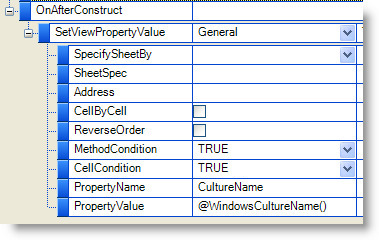
In this scenario, it is also important to create workbook scripts that are not written for a specific culture. To create a culture-neutral workbook script, use the @SEP() function in place of function argument separators in Excel formulas. For instance, instead of using a comma as the argument separator in the Address formula:
=Address(@LRow(), @LCol())
Use the @Sep() function, which is replaced at runtime with the list separator for the view’s culture. So, for example, if the view’s CultureName is "French (France)", the function returns a semicolon.
=Address(@LRow()@Sep()@LCol())
Caveats:
- The Regional Options do not affect the language used for Excel function names. All the Excel function names must be the English version.
- The character used to separate workbook script function arguments must always be a comma.
- Added properties to control whether the SpreadsheetGear WorkbookView workbook-related dialogs are launched in response to shortcut keys. The properties are included in the "UI — WorkbookView" category. (#755)

| AllowChartExplorer | Controls whether the Chart Explorer is launched when an Excel chart is active and the F6 + Shift keys are pressed. |
|---|---|
AllowRangeExplorer | Controls whether the Range Explorer is launched when a cell is active and the F6 + Shift keys are pressed. |
AllowShapeExplorer | Controls whether the Shape Explorer is launched when a shape is active and the F6 + Shift keys are pressed. |
AllowWorkbookDesigner | Controls whether the Workbook Designer is launched when the F3 key is pressed. |
AllowWorkbookExplorer | Controls whether the Workbook Explorer is launched when the F6 key is pressed. |
- Added the AllowFindAndReplace property to control whether the Find and Replace dialog is launched from within the view’s workbook when either the F5 + Shift keys, the Ctrl + F keys, or the Ctrl + H keys are pressed. By default, the property is set to True. (#756)
- Added AllowCopyCutToClipboard property to control whether the user is allowed to copy and cut from the view using the Ctrl+C and Ctrl+X keys, respectively. By default, the property is set to True. (#761)
There are a couple of considerations when deciding whether to allow copying and cutting from the view to the clipboard. When the copied range is pasted into an Excel spreadsheet, any hidden rows and/or columns within the copied range are automatically unhidden in Excel. However, setting AllowCopyCutToClipboard to False prevents a user from copying and pasting within a view and also from copying from one view and pasting into another view.
- The following is a complete list of the keys and related actions supported by the WorkbookView user-interface component:
| Key | Action |
|---|---|
F2 | Start Edit, Toggle Edit Modes |
F3 | Workbook Designer* |
F5 | Go To Dialog |
F5 + Shift | Find and Replace Dialog* |
F6 | Workbook Explorer* |
F6 + Shift | Range Explorer, Shape Explorer, Chart Explorer* |
F9 | Calculate |
F9 + Ctrl + Alt | Calculate Full |
Left | Move Selection Left |
Left + Shift | Extend Selection Left |
Left + Ctrl | End Left |
Right | Move Selection Right |
Right + Shift | Extend Selection Right |
Right + Ctrl | End Right |
Up | Move Selection Up |
Up + Shift | Extend Selection Up |
Up + Ctrl | End Up |
Down | Move Selection Down |
Down + Shift | Extend Selection Down |
Down + Ctrl | End Down |
Tab | Move Selection Right |
Tab + Shift | Move Selection Left |
Enter | Move Selection Down |
Enter + Shift | Move Selection Up |
Home | Select Left Cell |
Home + Ctrl | Select Top-Left Cell |
End | End Right |
End + Ctrl | Select Last Used Cell |
Page Up | Move Selection Up Entire Page |
Page Up + Shift | Extend Selection Up Entire Page |
Page Up + Alt | Move Selection Left Entire Page |
Page Up + Alt + Shift | Extend Selection Left Entire Page |
Page Up + Ctrl | Select Previous Sheet |
Page Down | Move Selection Down Entire Page |
Page Down + Shift | Extend Selection Down Entire Page |
Page Down + Alt | Move Selection Right Entire Page |
Page Down + Alt + Shift | Extend Selection Right Entire Page |
Page Down + Ctrl | Select Next Sheet |
Space + Shift | Select Entire Rows |
Space + Ctrl | Select Entire Columns |
Space + Ctrl + Shift | Select Entire Worksheet |
Backspace | Start Cell Edit, Delete Selected Shapes |
Backspace + Shift | Show Active Cell |
Backspace + Ctrl | Show Active Cell |
Delete | Delete Cell Contents, Delete Selected Shapes |
Escape | Cancel Cell Edit, Clear Shape Selection |
Ctrl + A | Select Entire Worksheet |
Ctrl + B | Toggle Bold Font |
Ctrl + C | Copy to Clipboard* |
Ctrl + D | Fill Down |
Ctrl + F | Find and Replace Dialog* |
Ctrl + H | Find and Replace Dialog* |
Ctrl + I | Toggle Italic Font |
Ctrl + R | Fill Right |
Ctrl + U | Toggle Underline Font |
Ctrl + V | Paste from Clipboard |
Ctrl + X | Cut to Clipboard* |
Ctrl + Y | Redo |
Ctrl + Z | Undo |
- Controlled by an Allow<dialog or action> property
- Added the BackgroundThreadWorkbookCalculation property to control whether calculation of Excel formulas is performed on a background thread, which can significantly improve performance for workbooks where formulas are used extensively. (#757)
Both the AllowFindAndReplace and BackgroundThreadWorkbookCalculation properties appear in the Behavior category for an Excel View and an Excel Essbase View. The following is a screenshot of the Excel View’s Behavior properties:

Workbook Scripting
New Functions: WindowsCultureName and ViewCultureListSeparator
The WindowsCultureName function returns the short name of the Windows regional options setting.
The ViewCultureListSeparator function returns the list separator defined for the culture configured as the view’s CultureName. This function allows for the creation of culture-neutral workbook scripts by using the @SEP function in place of the function argument separator in Excel formulas. (#759)
Refer to the CultureName property description in the Excel View and Excel Essbase View section above for additional information about these functions.
- New Method: Close
The Close method allows a workbook script to close the view. (#748)
- Added a Dimensions parameter to the DataPointDimValuesMembers, DataPointDimValuesAliases, and DataPointDimValuesDisplayed functions. (#751)
By default, the @DPDimValsMbrs, @DPDimValsAliases, and @DPDimValsDisp return a delimited list of all the contributing dimension/member pairs for a specified datapoint.
For example, the DataPointDimValuesMembers function can be used to return all the dimension/member pairs for the active cell:
@DPDimValsMbrs()
Using an example datapoint in the Sample Basic database, returns:
Year=Jan;Measures=Sales;Product=100-10;Market=New York;Scenario=Budget
The optional Dimensions parameter allows the script to specify the dimensions to be included in the result. For instance, the Dimensions parameter in the following example specifies that only the Market, Product, and Scenario dimension/member pairs should be included in the result. (Note that to use the default cell address, alias table, and delimiters, the parameters are not specified, but each must be denoted with a comma.) So, the function:
@DPDimValsMbrs(, , , , Market;Product;Scenario)
Using the same datapoint as the example above, returns:
Market=New York;Product=100-10;Scenario=Budget
Note: These functions can be used to generate part or all of the key items string for a comment range. However, it is always more efficient to get the key item values directly from the sheet when possible.
- Modified the following datapoint related functions to remove the need to specify the CellAddress argument. If the CellAddress argument is not specified, the function uses the active cell address (or the cell being processed if a cell-by-cell processing block is active).
DataPointDimValuesMembers
DataPointDimValuesAliases
Other datapoint related functions worked properly if the CellAddress argument was not specified, but the CellAddress argument was not documented as optional. The documentation was corrected for the following functions:
DataPointDimLevel
DataPointDimGeneration
DataPointDimOrientation
DataPointDimValueDisplayed
DataPointDimValueMember
DataPointDimValueAlias
DataPointDimValuesDisplayed
DataPointIsBlank
DataPointIsDouble
DataPointIsError
DataPointIsMissing
DataPointIsNoAccess
DataPointIsZero
DataPointIsReadOnly
DataPointIsReadWrite
Note: The AliasTable argument of several of these functions have also changed to indicate that the argument is optional. (#754)
- [Print Method] PrintToFile Overload added (#749)
The PrintToFile overload allows a view to be saved to a Microsoft XPS file. (Currently, saving to a PDF is not supported.)
Arguments include:
PrintWhat — Options include Selection, Sheet, and Workbook
PrinterName — Currently, only "Microsoft XPS Document Writer" is supported.
Filename — The base name and extension of the output file. The value can include workbook script functions and/or Excel formulas.
FolderOption — Options include MyDocuments or Desktop. If no option is specifed, the Folder argument is used.
Folder — When the FolderOption is not specified, indicates the path of the target folder where the output file is saved. The value can include workbook script functions and/or Excel formulas.
IncrementFilename — When True, the base file name is a appended with a "(<number>)" if a file with the same name already exists in the target folder. For example, if the output file name is "Income Statement.xps", and a file with that name already exists, the output file is named "Income Statement (2).xps".
The following example illustrates using the PrintToFile overload to save a view’s workbook to a file that uses the view’s ID as the base file name with an .xps extension. The file is saved to the MyDocuments folder.

- New functions added to support getting information for a member cell: (#753)
MemberCellDimensionNumber
MemberCellIsDimension
MemberCellIsExplicitlyShared
MemberCellIsImplicitlyShared
MemberCellIsLabelOnly
MemberCellIsNeverShare
MemberCellIsParent
MemberCellIsStoredData
Dodeca Framework Build 1712
August 18, 2009
The version of SpreadsheetGear has been upgraded from 4.0.11.106 to 5.1.1.112. (The SpreadsheetGear WorkbookView user control is the spreadsheet user-interface component used for Excel-based views.) Among the new features are the following:
- Support for the 93 functions that are in the Excel 2003 Analysis Toolpak, as well as the undocumented DATEDIF function. This brings the total number of supported functions to 331.
- Drag Fill / Auto Fill user interface, including support for numbers, dates, times, month names, day names, and certain text patterns.
- Charting enhancements, including chart axis title rendering, bubble chart rendering, and rotated text support.
- Rotated text support (in cells and charts)
- Printing support for the active sheet, a selection, or an entire workbook.
Printing Tools
- Print Sheet, Print Workbook, and Print Selection
Print Preview Sheet, Print Preview Workbook, and Print Preview Selection (#739)
The previous Print and Print All Worksheets tools (although still supported) have been replaced with tools that print the active sheet, the entire workbook, or a selection. An Essbase Excel view or an Excel view can now be configured with a ViewToolbarsConfigurationID that references a toolbar configuration that contains the Print popup menu tool as well as the Print Preview popup menu tool. These popup menu tools are configured as segmented popup menu tools, which behave like a button when the tool’s icon is clicked and like a menu when the dropdown arrow is clicked. Clicking the icon is the same as clicking the Print Sheet tool (for the Print popup menu tool) and Print Preview Sheet tool (for the Print Preview popup menu tool) from the dropdown list.
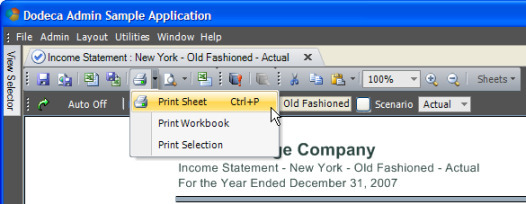
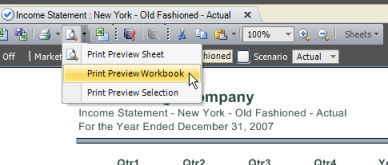
An Essbase Excel view or an Excel view can also be configured with a MergeableToolbarsConfigurationID that references a toolbars configuration that contains the File / Print and Print Preview menus, which contain the related print and print preview tools.
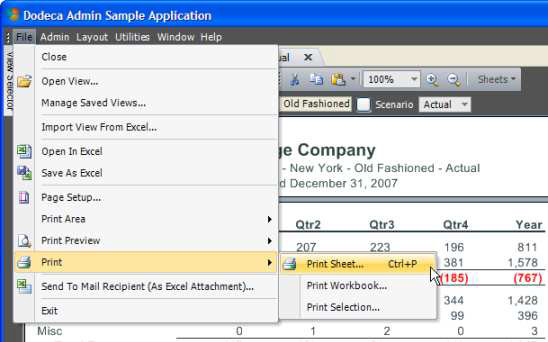
In keeping with the Excel paradigm, when a print tool is selected from the view’s toolbar, the print dialog is not displayed; however, when a print tool is selected from the File/Print menu, the print dialog is displayed.
These tools have been added to the appropriate toolbars configurations in the metadata starter kit. If the starter kit was used to seed a tenant’s metadata and if changes have not been made to the toolbars configurations, then the toolbars configurations can be imported from the metadata_starter_kit.zip installed in the installation path, such as C:\Program Files\Applied OLAP\Dodeca Framework 4.1.0.0\metadata, which will overwrite the existing toolbars configurations.
If changes have been made to the toolbars configurations, such as by adding custom context menus, then the new print tools can be added to an existing toolbars configuration without overwriting the existing toolbars configurations.
The following describes the steps necessary to add the Print and Print Preview menus to a mergeable toolbars configuration, such as Essbase View Main All:
From the Toolbars Configurations Metadata Editor, select a toolbars configuration that is used as a mergeable toolbars configuration. Then, open the Toolbars Designer.
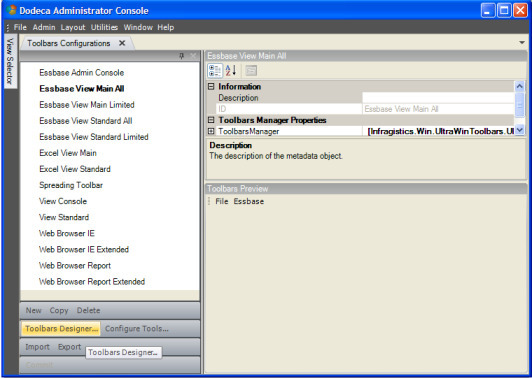
Since the previous tools are no longer needed, delete the Print All Worksheets, Print Preview, and Print tools.

To add the new tools, click the Import Standard Tools and Toolbars button located at the lower left. When the wizard opens, advance to the Select Popup Menu Tools page by clicking next. Then, check the SGPrintMenu and SGPrintPreviewMenu tools.
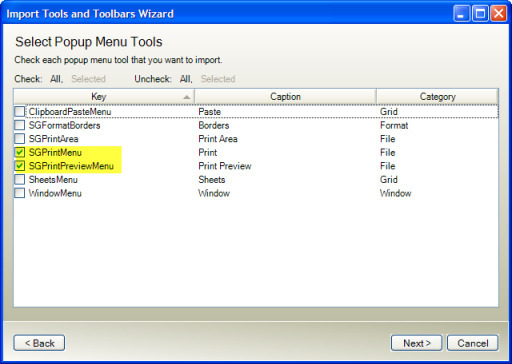
Click Next. The print tools are automatically checked. Now, click Finish.
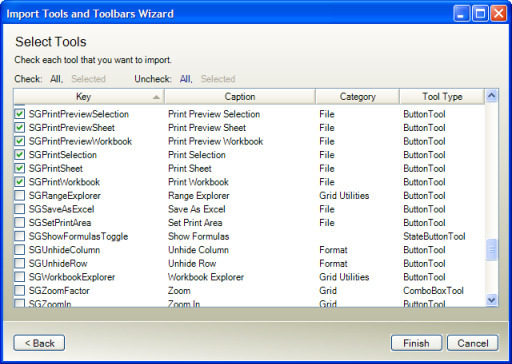
To add the Print and Print Preview menu tools to the File menu, select the Popup Menu Designer tab. Then, select the File menu from the Popup Menu Tool dropdown list at the upper left.
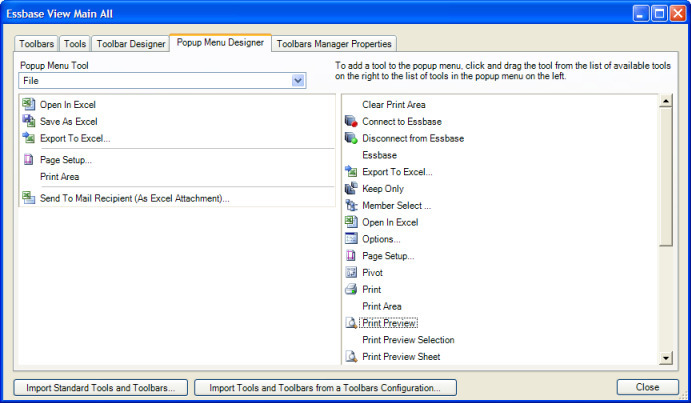
Drag the Print Preview and Print popup menu tools from the list of available tools in the right panel to the list of tools in the File popup menu tool in the left panel.
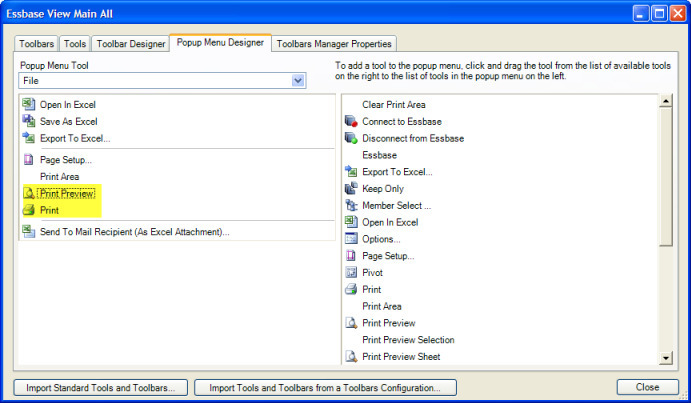
By default, the Print and Print Preview popup menu tools are configured as segmented popup menu tools. When displayed in the File menu, it is more appropriate for the tools to be configured as standard popup menu tools.
For both the Print and Print Preview popup menu tools, change the DropDownArrowStyle from Segmented to Standard.

Since the Print tools display the Print dialog when clicked from the File menu, append an ellipsis "--" to the caption of the Print Sheet, Print Workbook, and Print Selection tools.
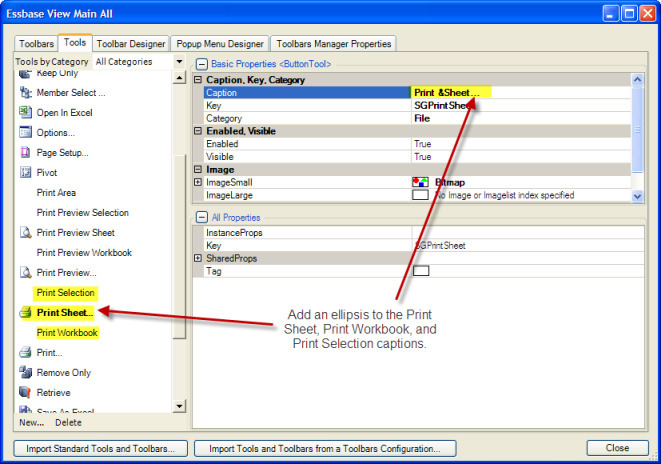
The steps are similar for adding the Print and Print Preview tools to a toolbars configuration that is assigned to a view as the ViewToolbarsConfigurationID.
In Step 5, instead of adding the Print and Print Preview popup menu tools to the File menu, the tools are added to the Standard toolbar using the Toolbar Designer tab.
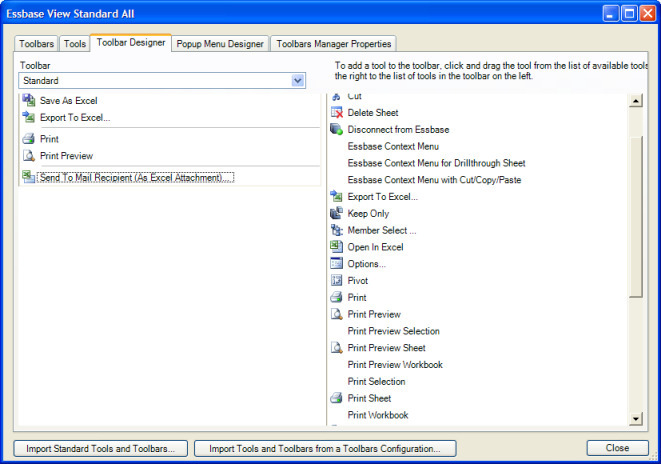
Steps 7 and 8 are not necessary.
If you have any questions about the new print and print preview tools and/or need assistance with updating the toolbars configurations, please contact us at support@appliedolap.com.
Workbook Scripting
- New Method: Print
The Print method provides two overloads: Print and Preview. Both overloads support a PrintWhat argument, which can be set to Sheet, Workbook, or Selection. The Print overload also supports a ShowDialog argument, which controls whether the Print dialog is displayed. (#740)
Dodeca Framework Build 1673
July 30, 2009
Application
- Authentication Services
The following Essbase authentication services are now supported out of the box: EssbaseUserRolesFromSqlPassthroughDataSets and EssbaseUserRolesFromGroupNames
When an application is configured with either of these services, the user is prompted at startup for an Essbase user name and password. The service authenticates the user by attempting to connect to the Essbase database that is configured for the service.
With the EssbaseUserRolesFromSqlPassthroughDataSet* service, the service can optionally be configured to query a relational database for the role or roles to which the user is assigned.
With the EssbaseUserRolesFromGroupNames service, the names of the Essbase groups to which the user is assigned are obtained. (#715)
*The EssbaseUserRolesFromSqlPassthroughDataSets service provides the same functionality as the EssbaseAuthenticationService, which is supported by the EssbaseAuthentication module. The module was previously included with the metadata_starter_kit.zip. If you are currently using the EssbaseAuthenticationService, we recommend that you start using the EssbaseUserRolesFromSqlPassthroughDataSets instead, and remove the EssbaseAuthentication module from your application(s).
Please note that the EssbaseUserRolesFromGroupNames service requires an updated dodeca-essbase servlet and is only supported for Essbase versions 9.3.0 and higher.
- [View Selectors] Fixed Issue: When a hierarchy that is configured for a view selector no longer exists, the following error is presented: "Unable to initialize the view selector. Unable to get the hierarchy metadata. Unable to retrieve the checksum for binary artifact "SAMPLE.HIERARCHY.CategorizedViewsSG.1". There is an error in XML document (2, 184). <BinaryArtifacts xmlns=''> was not expected."
Resolution: A more informative error message is now presented, such as "Unable to initialize the view selector. Unable to get the "<hierarchy ID>" hierarchy metadata. The ViewSelectorTree is configured with the hierarchy "<hierarchy ID>", which is not an existing hierarchy ID." (#717)
Comments
Fixed Issue: When a comments cell value is cleared using the Delete key, the cell value is set to an empty string, instead of null.
Resolution: Clearing a comments cell value now sets the value to null. (#720)
- [CommentRange] Modified to throw the following exception when a comment range contains discontiguous areas:
A comment range contains discontiguous areas. A comment range can only contain a single area. CommentRange.Caption = "<CommentRange.Caption>", CommentRange.Address = "<CommentRange.Address>". (#707)
- [CommentRange] Fixed Issue: When a comment range’s Address property does not match the actual defined range based on a case-sensitive comparison, an exception similar to the following is raised: "Error setting up comments. AppliedOLAP.Dodeca.Common.Range failed. No defined names matching <address property value>." For example, if the Address property is set to My.Range and the actual range name is My.range, the exception occurs.
Resolution: A case-insensitive comparison is now used to determine whether the actual range name matches the configured range name. (#703)
- [CommentRange] Fixed Issue: When a comment range is configured with BaseKeyItems and the KeyItemsString is not specified, comments cannot be added to cells within the range.
Resolution: When BaseKeyItems are defined and no KeyItemsString is specified, the key items for each cell (or each group of merged cells) within the range are the same. (#706)
[Save Comments] Fixed Issue: After clicking the Save Comments tool, the user is prompted whether to save the changes, lose the changes, or cancel the build. When the user cancels the build, the view remains covered.
Resolution: When the user cancels the build, the view content is uncovered. (#709)
Client-side Optimizations:
- When a comment range contains merged cells (or groups of merged cells), the KeyItemsString is only evaluated for the origin cell of each merged group, instead of each individual cell.
- When a comment range’s CommitPolicy is set to User, the amount of time required to save the comments has been significantly reduced. Previously, the amount of time increased progressively with each subsequent save. (#721)
- Optimization Recommendation: BaseKeyItems should typically only be used when the KeyItemsString is not a formula that excludes cells within the comment range. For example, if the KeyItemsString excludes locked cells within the range, then BaseKeyItems should not be used, because the BaseKeyItems always apply to all cells within the range. Although the comment range can be configured to prevent the user from adding comments to a locked cell, as in this example, there is overhead incurred at runtime for each cell that potentially can have associated comments. To optimize performance, include shared key items in the KeyItemsString instead of using the BaseKeyItems, when any cell within the comment range is excluded based on the resolved KeyItemsString.
- Server-side Comment Query Optimization: Previously, the comment query functionality issued a query to the underlying relational server for each comment id or key hash posted to the server. In certain circumstances, this could cause a large number of queries to be posted to run against the relational server, which is inefficient. The query algorithm was refactored on the server to use the SQL 'IN' clause to make the queries more efficient for queries that pass either a CommentID or a KeyHash code to the server. (#712) Note: The number of comments included in the IN clause may be configured in the dodeca.properties file by setting the dodeca.comments.query.batch.size property. The default value is 1000.
dodeca Metadata Servlet
Fixed Issue: The server uses many resources when querying large Binary Artifact objects. This issue is encountered, for example, after a very large Excel workbook has been uploaded to the server as a binary artifact. When the Binary Artifact Metadata Editor is then subsequently opened, the server appears to use too many resources when querying for the list of existing binary artifacts.
Resolution: The Dodeca metadata server was refactored to address this issue. (#711)
dodeca-essbase Servlet
Fixed Issue: Values sent to an ASO database are not persisted, although no error is reported.
Resolution: Updated the Essbase locking mechanism for ASO to properly commit writeback transactions. (#708)
New functionality: The follow methods were added to get user and group information:
- GetOlapGroups
- GetOlapGroupsForUser
- GetOlapUsers
GetOlapUsersForGroups
GetOlapGroups returns a list of Essbase groups. Optionally, an application and/or database may be passed to the method to filter the results to include only groups that have access to the application/database. If there are no groups that meet the criteria, or for pre-version 9.3.0 servers, this function will return an empty <Groups/> element.
GetOlapGroupsForUser gets a list of Essbase groups that has as a member the username used to connect to the Essbase server. If the user belongs to no groups, or for pre-version 9.3.0 servers, this function will return an empty <Groups/> element.
GetOlapUsers returns a list of Essbase users. Optionally, an application and/or database may be passed to the method, along with an authentication protocol and a flag to indicate externally authenticated users only, to filter the results to include only users that meet the specified criteria. If there are no users that meet the criteria, or for pre-version 9.3.0 servers, this function will return an empty <Users/> element.
GetOlapUsersForGroups returns lists of Essbase users that are members of given Essbase groups. This method requires administrative privileges on the Essbase server to run successfully. If there are no users in the groups, this function will return empty <Group/> elements nested inside an empty <Groups/> element. On pre-version 9.3.0 servers, this function will return an empty <Groups/> element. (#727)
Fixed Issue: Report script {SKIP} commands used in the GetMemberStringsFromReport and GetMemberObjectsFromReport methods did not work.
Resolution: The GetMemberStringsFromReport and GetMemberObjectsFromReport methods were originally written to return only non-blank rows returned from a report script. The functionality was modified to support the report script language {SKIP} command. (#728)
Essbase Connections Metadata Editor
- [Import Connections]: Changed the default Connection ID format from [Server].[Application].[Database] to [Application].[Database], since many Dodeca administrators use a different Essbase server for development versus production. The [Server] substitution string is still supported and can be added to the connection ID format as needed. (#729)
Essbase Selector Metadata Editor
[Import Dimensions] Fixed Issue: Toggling the display of attribute dimensions unchecks all checked dimensions.
Resolution: Toggling the display of attribute dimensions unchecks only attribute dimensions and only when the attribute dimensions are toggled from visible to hidden. (#734)
[Import Dimensions] Added ability to toggle the checked state of all dimensions. (#735)
Essbase Selector Tree
- [MemberToolTipOptions ]: Added a Consolidation operation option to the MemberToolTipOptions. The possible consolidation values include: Add, Subtraction, Multiplication, Division, Percent, Ignore, Never (#731)
- [MemberToolTipOptions]: When the Comment or Formula option is enabled, but a comment or formula is not defined, the "Comment" or "Formula" label is not displayed in the member tip. (#731)
Essbase Send Tool
- Fixed Issue: The Send tool was inappropriately prompting the user to confirm an operation when a non-sendable sheet had been modified. (#737)
Excel Essbase View
- [AutoFitColumnWidth] Fixed Issue: When an Essbase view’s AutoFitColumnWidth property is True, hidden columns with the retrieve range become visible.
Resolution: Hidden columns within the retrieve range are not auto-fit and remain hidden. (#704)
- [Selector] Fixed Issue: When the view has a selector configured with a selector list that has the AutoOpenTree or AutoOpenListbox property set to True and the ToolVisibleInToolbar is also set to True, the selector is hidden with the view opens. (#719)
Excel Formatting Tools
- Fixed Issue: The Increase Decimal and Decrease Decimal formatting tools cause the client application to lock up when a large number of cells is selected.
Resolution: Modified the approach to be consistent with the equivalent Excel tools, which adjust the decimal places based on the active cell’s number format and then set the number format of all the cells in the selected range to the modified format assigned to the active cell. This approach also resolved the issue encountered when the selection includes a large number of cells. (#702)
Metadata Editors
- After committing metadata changes in any of the following metadata editors, the previously selected metadata instance is restored as the active instance: Applications, Views, View Property Sets, Selector Lists, Toolbars Configurations, Binary Artifacts, Workbook Scripts, Essbase Connections, Modules, SQL Passthrough Datasets. (#723)
Collapse All / Expand All context menu options are available for the Settings area in the Applications, Views, and View Property Sets metadata editors. (#724)
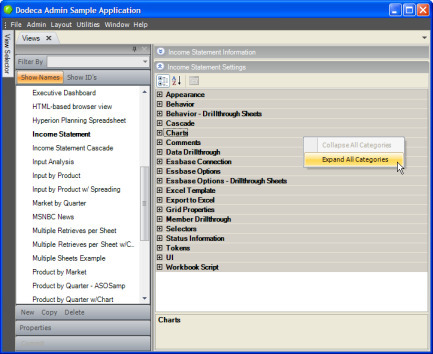
View Metadata Editor
- NamedPropertySets Editor — The dialog now has a splitter bar, which allows for resizing the width of the Defined Property Sets list. (#722)
Workbook Scripting
- [SetSelector Method] Fixed Issue: The Clear overload does not clear the selection. (#710)
- [Import View from Excel] Enhancement: When an Excel Essbase view is imported from Excel, a workbook script can access the external workbook using external references. (#716)
The following events are raised during the import processing:
BeforeExcelImport, AfterExcelImport, BeforeImportWorksheet, and AfterImportWorksheet
A "WorkbookName" event property has been added for each of these events, which allows a workbook script to use Excel external references to access the Excel file, such as with the following formula:
='[@EPVal(WorkbookName)]Input'!@ACell()
The @EPVal(WorkbookName) evaluates to the name of the external workbook, which is resident in memory during the import, so the workbook is treated like an opened external workbook in Excel. So, for example, this allows a workbook script to copy values, formulas, and/or formatting, etc. from the external workbook into the view’s workbook. The script can also prevent the default processing* from being performed by using the CancelEvent method from within the BeforeImportWorksheet event link.
*By default, the data within each send range is copied from the external workbook to the view’s workbook.
By way of example, the following workbook script illustrates this functionality:
Let’s say that when a specific sheet is imported that you want to set the value of each unlocked cell within a specific range in the view’s workbook to the value from the corresponding cell in the external sheet. The DoBeforeImportWorksheet in the screenshot below is configured accordingly:

The MethodCondition uses the BeforeImportWorksheet event property "SheetName" to restrict the processing of this method to only the Input sheet. This is important when the workbook contains multiple sheets.
=IF ("@EPVal(SheetName)"="Input", TRUE, FALSE)
The CellCondition excludes locked cells based on whether the cell in the view’s workbook is locked.
The Entry uses the BeforeImportWorksheet event property "WorkbookName" to reference the external workbook that is being imported. The value is obtained from the same cell location in the external worksheet as the current cell within the CellByCell loop.
='[@EPVal(WorkbookName)]Input'!@ACell()
Using the CopyRange method with the Specify overload could be used to copy an entire range from the external workbook by using an external reference for the CopyRange argument; a local range within the view’s workbook as the PasteRange; and the PasteType (i.e. All, Formats, Formulas, Values, etc.) to control what gets copied.
Note: The Before/AfterImportWorksheet events also expose a SheetName event property, which can be accessed using @EPVal(SheetName).
Dodeca Framework Build 1603
June 8, 2009
Application
- New setting: TabbedWindowShowTab controls whether the tab area of tabbed window groups is visible. (#687)
- New setting: ViewSelectorAllowResize controls whether the view selector can be resized by the user. (#687)
- Default Admin Toolbars: Added Utilities/Clear Workspace Layout Cache tool, which clears the workspace layout from the local cache. When the application’s CacheWorkspaceLayout is set to True, the workspace layout is cached when the application is exited. (#694)

- Fixed Issue: When using the Default Admin Toolbars (or the Essbase Admin Console toolbars configuration from the metadata_starter_kit), the order of the Window and Help menus is reversed when a view that has a MergeableToolbarsConfigurationID is opened. (#696)
Excel Essbase View
- Fixed Issue: Worksheet tokens that contain special characters are not being replaced properly. With this build, in addition to square brackets, which are already supported, worksheet tokens can now contain the following additional special characters:
+ ^ $ . | \{ } ( ) * ?
(#684)
- Modified the ChartRetrieveRangeInfo: Added TitleTop and SheetName settings
TitleTop is the text displayed as the title at the top of the chart within the chart control area. The value can be tokenized.
SheetName is the name of the sheet that contains the data to be represented by the chart. The SheetName setting is used instead of the RetrieveRangeName when the "used range" of a worksheet represents the Essbase retrieve range. To configure a chart to represent the used range of a worksheet, use the SheetName to specify the name of the worksheet, and leave the RetrieveRangeName blank.
The RetrieveRangeName is not a new property, but the description has been updated per the addition of the SheetName property.
RetrieveRangeName is the defined range name (i.e. Ess.Retrieve.Range.<identifier>) that represents the Essbase retrieve range that contains the data to be represented by the chart. When the chart represents a sheet-level range, the range name should either include the worksheet name as part of the range name by using the Excel defined name convention, such as 'Market by Quarter'!Ess.Retrieve.Range.1 OR use the SheetName property to specify the name of the worksheet. (#691)
Excel Essbase View, Ad hoc Essbase View, and Script Essbase View
- When an Essbase view is configured to use a view UI that contains one or more UltraChart instances, such as WorkbookViewAndUltraChart and WorkbookViewAndUltraChart2, the charts are drillable. (#693)
Export Metadata to Local Zip File Utility
- Fixed Issue: If the specified zip file already exists and is read-only, the application aborts with an unhandled exception. (#683)
Toolbars Configuration Metadata Editor
- Toolbars Designer — Modified to display both the tool caption and key as the tooltip on the Toolbars Designer and Popup Menu Designer. (#697)
- Import Standard Tools and Toolbars (and Import Tools and Toolbars from a Toolbars Configuration) — The Toolbars, Popup Menus, and Tools are now sorted in ascending order by key. (#698)
View User-Interface
- The WorkbookViewAndUltraChart and WorkbookViewAndUltraChart2 view user-interfaces, which are supported as options for a view’s WindowsViewUIObjectTYpeID setting, no longer hide the dockable control panes when the view is covered. Instead, the dockable control panes remain visible, but the chart controls that are contained by the windows are hidden, which results in a better visual presentation when the view is built. (#686)
Workbook Script
- Fixed Issue: If the Toolbars Configuration Metadata Editor’s Configure Tools dialog is used to add or modify a WorkbookScriptToolController tool that has a workbook script configured as the WorkbookScriptID argument and the ProcedureName, EnabledPropertyName, CheckedPropertyName, ValuePropertyName, or VisiblePropertyName argument is specified by selecting a value from the property value’s dropdown list, then the following exception is thrown the next time a view that uses the same workbook script is opened: "Unable to open view <ViewID>. Specified method is not supported." There are also other possible scenarios that can result in the same exception. (#685)
Workspace Layout
- This is a BREAKING CHANGE.
For an application for which either of the following is true, any existing workspace layout will have to be recreated.
\1. The ViewSelectorCaption value is set to something other than the default value, which is an empty string.
\2. The ViewSelectorCaptionTab is set to something other than the default value, which is "View Selector"
If the application’s WorkspaceLayoutBinaryArtifact setting is assigned a workspace layout, the view selector may not be docked properly when the application starts up. If not, use the Application Setup Utility to clear the WorkspaceLayoutBinaryArtifact setting. You should then be able to startup the application, recreate the workspace layout binary artifact, and then assign the new layout to the application. (#688)
Dodeca Framework Build 1569
May 7, 2009
Comments
- Fixed Issue: In the View Metadata Editor, the Comment Range Configurations Editor and Comment Key Items Editor do not update the item’s label in the list when a comment range’s caption or a base key item’s name is changed. (#672)
Excel Essbase View
Fixed Issue: If the AllowSend setting is True and the view’s toolbar contains the Send tool, the user is prompted when attempting to rebuild the view if any values have changed. If the user clicks "No", the rebuild is cancelled, but the view remains covered. This issue was introduced in Build 1498 with a change to the Build View tool. The issue is being addressed with a change to the Send tool. (#680)
View Selector Tree
- Fixed Issue: The tree displays duplicate root nodes for a hierarchy when the hierarchy is mapped to multiple roles (and the current user is assigned multiple roles) and the HierarchyRootNodeDisplayPolicy is Hierarchy. (#678)
View Selectors
- Enhancement: When the ViewSelectorProperties AllowEditViewMetadata setting is True, an "Edit Excel Template" item is displayed on the context menu if the view is assigned an Excel template binary artifact. When the menu item is clicked, the Binary Artifacts metadata editor is opened or activated and the view’s Excel Template binary artifact is automatically selected. This menu item is only displayed for an Excel view or an Excel Essbase view. (#677)
This capability is supported for both the ViewSelectorExplorerBar and the ViewSelectorTree. It is intended for use with an Admin application as a way to quickly access a view’s Excel template binary artifact directly from the view selector. By default, the setting is False to avoid unintentionally giving end users access to the metadata.

Workbook Scripting
- Fixed Issue: When the BuildRangeFromScript method’s CopyFromRange argument is assigned a range and either rows or columns are being added (Insert = False), the method increments the current row (when adding rows) or current column (when adding columns) by 1 instead of the total number of rows/columns in the range. This causes all but the first row (when adding rows) or first column (when adding columns) of each copied range to be overwritten by the subsequent copied range. (#682)
- Modified EventPropertyValue @EPVal(<PropertyName>) function: The function now allows the PropertyName to be an EventArg that represents an object reference followed by a period "." and property name, which can also be an object reference followed by a period "." and property name, and so on. (#681)
Dodeca Framework Build 1552
April 21, 2009
Comment Range
- Added Formula Editor Dialog for the following view comment range settings: AllowAddString, AllowDeleteString, AllowUpdateString, ContextString, and KeyItemsString. (#671)
Comments Explorer
- Added support for multi-line comments. The Comments Explorer displays the entire comment, including all the comment lines, and wraps the text as needed when the width of any line exceeds the width of the comment field. When a comment field is activated by the user, a pop-up editor window displays on top of the field. The user can advance to a new line using the Enter key. To exit the cell, the user can either press the Tab key or click the mouse outside the edit window. Pressing the Escape key cancels the edit. (#669)
- Optimized the Comments Explorer to address the delay when entering a comment encountered when the view contained many comments ranges. (#665)
- Optimized the implementation of the saving of comments by avoiding reloading the comments when the save is in response to the view being rebuilt, refreshed, or closed. (#666)
- Modified the prompt to include the name of the view when the user attempts to build, refresh, or close a view that has unsaved comment changes. (#674)
- Set the Horizontal/Vertical orientation state button caption to "Vertical" when "on" and "Horizontal" when "Off". The caption is used as the tooltip. (#676)
- Fixed Issue: The "Response" button is enabled when no comment rows exist and when no comment is selected.
Essbase Login Service
- A new Essbase Login Service, EssbaseLoginDialogWithGenericCaption, is now available that does not display the Server/Application/Database in the login dialog caption. (#670)
Metadata Editors
- The following secondary forms were modified to display with a larger initial size and they now contain a splitter bar: SQLPassthroughDataSet Query Editor, Comment Range Configuration Editor, Comments Key Items Editor, and the Essbase Excel View’s Chart Retrieve Range Information Editor. (#668)
Selector Listbox (and Essbase Selector Listbox)
- Fixed Issue: The "Select All" button is not enabled when the listbox is displayed. (#675)
Workbook Script Metadata Editor
- Fixed Issue: When the active workbook script is deleted and the user clicks the Commit button, an "Object reference not set to any instance of an object" is thrown. (#667)
Dodeca Framework Build 1527
March 31, 2009
Comments
- Added LastUserID and LastDateTime to the Comments Explorer. (#656)
- Added tokens related to the current comment before AllowUpdateString and AllowDeleteString are evaluated. The following tokens are available for the current comment: [T.Comment.CreatedBy],[T.Comment.CreatedDate], [T.Comment.UpdatedBy], [T.Comment.UpdatedDate] This allows the developer to use formulas for AllowUpdateString and AllowDeleteString that are evaluated based on the values of the comment dates and UserIDs. (#661)
- The displayed comment dates are converted to local time/date format. (#655)
- Added CommentRange.AllowAddString property: Allows a developer to control whether comments can be added on a cell-by-cell basis within a comment range. (#660)
Added CommentRange.ExcelFormat property: Allows a developer to specify how the Excel comments are constructed. The options include the following:
- Comment, Comment only
- UserComment, Username: Comment
- TimeComment, (m-d-yy h-m-s): Comment
- UserTimeComment, Username (m-d-yy h-m-s): Comment (#659)
- Added CommentRange.DateFormat property: Allows a developer to specify the format of the dates when displayed in the Comments Explorer (#659)
- Modified the Comments Explorer to display the CreatedBy and CreatedDate in the UpdatedUserID and UpdatedDate columns if the latter two columns are empty. This allows the developer to only display the latter two columns, rather than having to display Created columns and LastUpdated columns. (#659)
Toolbars Configuration MetadataEditor
Fixed the following issues with the Toolbars Designer:
- The ImageSmall in the Basic Properties grid cannot be cleared.
- A tool’s image in the tools list is not updated when the small image is changed. This is an issue when the ImageSmall setting is edited in the Basic Properties grid and also when the SharedProps.AppearancesSmall.Appearance.Image is edited in the All Properties grid.
- The Commit button is not enabled when the small image changes. (#664)
View Hierarchies Metadata Editor
- The Name setting for a hierarchy item is now optional. If not specified, the ID is used instead. This avoids having to enter both an ID and a name when an item is created.
Hierarchy Validation
A specific hierarchy can now be validated on demand by selecting Validate Hierarchy from the context menu.
Note: All hierarchies are automatically validated prior to committing.
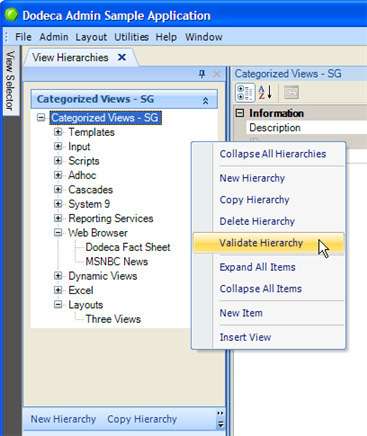
The errors are reported and the offending items are highlighted, but the errors do not prevent a hierarchy from being committed. The view selectors ignore non-existent views and invalid workspace layout items.
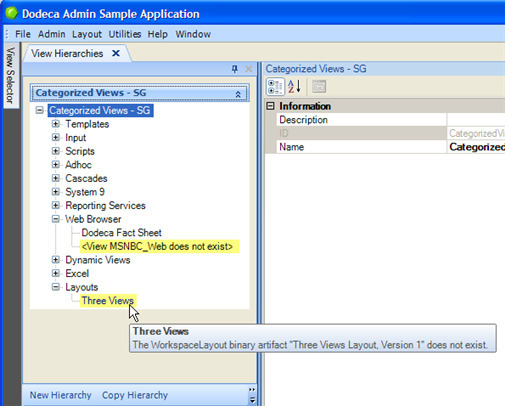
Beginning with this build, potential validation errors are 1) a non-existent view included in a hierarchy; 2) a workspace layout item that is not assigned a layout; and 3) a workspace layout item that is assigned a layout that does not exist.
Workbook Scripting
Added SendEmail Method: The arguments, which can all be calculated within the context of the view, include: AttachView, Bcc, Cc, Message (body), Prompt (whether to simply send or wait for use to click Send), Subject, and To (recipient) (#658)
Workspace Layout
The physical layout of the windows in a Dodeca application workspace, including the docked window that contains the view selector and the tabbed windows that contain specific views, saved views, or metadata editors, can now be captured, persisted, and restored.
Workspace layouts can be utilized in several ways:
- A workspace layout can be saved as a binary artifact, associated with an application, and automatically loaded at startup. So, for example, an application can function as a dashboard by configuring the application with a pre-defined layout of views that are automatically opened and presented at startup.
- A workspace layout can be saved as a binary artifact, added to a view hierarchy, and can then be opened and loaded from a view selector. As with the previous example, these predefined layouts can be thought of as dashboards.
- A workspace layout can be saved as a file to the file system and then opened and loaded on demand. This gives a user the ability to create a personal library of layouts, which are persisted locally.
An application can be configured to cache the current layout when the application is exited, then automatically restored at startup.
The default Admin application toolbars configuration contains the Layout menu.
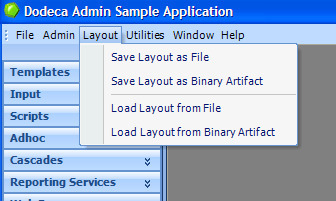
The Save Layout as Binary Artifact and Load Layout from Binary Artifact tools are intended for Admin use only. A WorkspaceLayout binary artifact can also be created using the Binary Artifact Metadata Editor. The Save Layout as File and Load Layout from File can be added to the toolbars configuration used by a User application to allow users to persist and load layouts locally.
The Save Layout as Binary Artifact and Save Layout as File tools save the current workspace layout, which includes the 1) docked location, size, and pinned/unpinned state of the view selector and 2) the location and grouping of the tabbed windows that contain specific views and metadata editors.
The WorkspaceLayout binary artifact can be associated with an application using the WorkspaceLayoutBinaryArtifact property. The layout is automatically loaded at startup. When the CacheWorkspaceLayout setting is True, the current layout is cached locally when the application exits and loaded at startup.
If layout caching is enabled and the WorkspaceLayoutBinaryArtifact is assigned a workspace layout, then the metadata-based layout is loaded the first time the application is run and then the current layout is cached each time the application is exited and loaded the next time the application starts up.

The layout can also be added to a hierarchy, which allows a user to open layouts from the view selector Explorer Bar or tree.

Remarks:
- A workspace layout does not retain content-related information for the views that are open when the layout is saved. When a layout is loaded, each view in the layout is automatically opened just as if the view was opened from the view selector. All of a view’s current metadata settings are applied and, if the view contains selectors, the default selections are set based on the current configuration, and not on the selections in place when the layout was saved.
- If the layout contains a saved view, the last version of the saved view is opened.
- Any view or saved view that was deleted after the layout was saved is ignored when the layout is loaded. In other words, no error is generated.
- Since any metadata editor that is open when a layout is saved is included in the layout and opened when the layout is loaded, care should be taken to not inadvertently include metadata editors in layouts that are used by non-Admin applications.
Dodeca Framework Build 1498
March 9, 2009
Application Metadata Editor
- The ViewSelectorProperties.HierarchyToRoleMapping now allows multiple hierarchies to be mapped to the same role. (#651)
Toolbars Configuration Metadata Editor
- Fixed Issue: When a toolbar is repositioned by dragging and dropping the toolbar in the Preview area, the Commit button is not enabled, and if committed, the new location is not persisted. (#646)
- Fixed Issue: Step 1) A new toolbars configuration is created either by using the New tool or by copying an existing toolbars configuration. Step 2) The Configure Tools dialog is used to configure a tool, and the new toolbars configuration is committed when the dialog is closed. Step 3) Go to the View Metadata Editor and attempt to assign the new toolbars configuration to a view. The dropdown list does not contain the instance. (#654)
View Hierarchy Metadata Editor
- Fixed Issue: Unable to drag an item and insert above another item. (#649)
- When the user clicks the right mouse button on a node, the node automatically activates and becomes the selected node, and the context menu displays. Previously, to display the context menu for a node, the node would have to be selected with the left mouse button first, and then clicked with the right mouse button. If the right mouse button is clicked within the tree, but not on a node, the context menu is displayed for the currently selected node, and if no node is selected, the context menu contains only non-item options. (#650)
Workbook Scripting
- Added SetSelector method. The General overload supports setting the selection, setting whether the selector requires a selection, and/or setting the visibility of the selector tool in the toolbar. The Clear overload clears the selection. (#652)
- Modified AfterBuild event to be cancellable. This allows the workbook script to cancel the build processing upon completion. When the AfterBuild event is cancelled, none of the usual "after build" processing occurs, such as uncovering the view content, updating the view caption, refreshing the other tools, etc. (#647)
Workbook Script Metadata Editor
- Fixed Issue: Error encountered when saving a script that contains a procedure with no methods. This issue was introduced in the last build. (#653)
- Procedure validation: On commit, when an event link is assigned a procedure that has been deleted, the user is prompted with the following options: 1) Remove the event link, 2) Clear the procedure name from the event link, or 3) Cancel the deletion of the procedure. (#648)
Dodeca Framework Build 1483
February 25, 2009image::image504.jpeg[image,width=16,height=16]
View Selector Tree
- Fixed Issue: When the AllowEditViewMetadata property set to False, the context menu contains the Edit View (and Edit WorkbookScript) items. Although the items do not contain the view ID (and workbook script ID), the user is still able to navigate to the metadata editor.
Dodeca Framework Build 1481
February 24, 2009
The version of SpreadsheetGear has been upgraded from 4.0.8.104 to 4.0.11.106.
Application
- Changed the default value for the ViewSelectorCaptionTab setting to "View Selector" and for the ViewSelectorToolTip setting to "To open a view, click on the view name with the left mouse button." Previously, the default for both settings was an empty string. (#608)
Application Branding — An image, such as a company logo, can be displayed at the top of the view selector. In the View Selector section of the application metadata, the ViewSelectorProperties includes Image and ImageBackColor settings. The settings are supported for the ViewSelectorExplorerBar and the ViewSelectorTree. (#642)
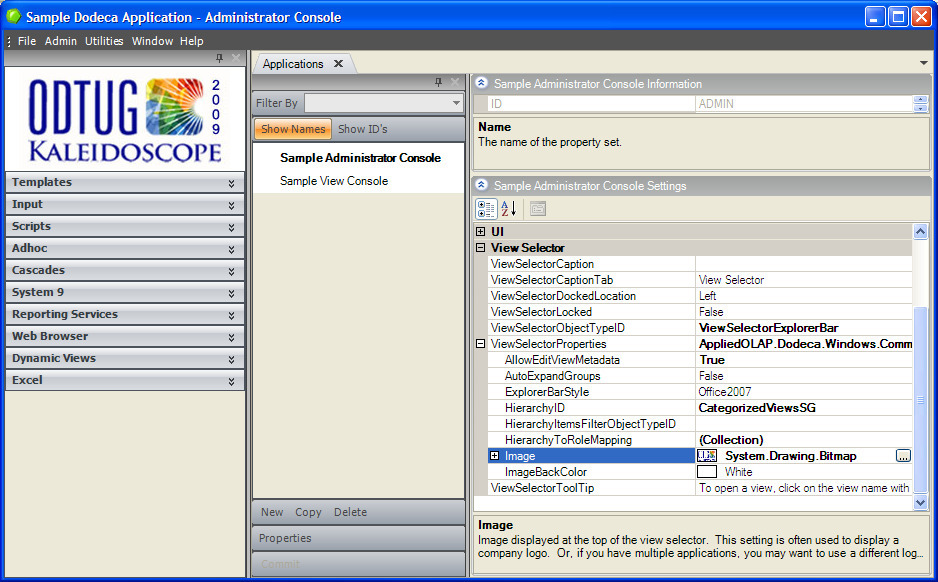
At runtime, the image is scaled only when the width of the view selector is less than the width of the image.
- An application can be configured to allow navigating from a view in the view selector to the view’s properties in the View Metadata Editor or to the view’s workbook script in the Workbook Script Metadata Editor. When the ViewSelectorProperties AllowEditViewMetadata setting is True, an "Edit View" item is displayed on the context menu. The item opens or activates the View Metadata Editor and selects the view’s metadata. If the view is assigned a workbook script, an "Edit Workbook Script" item is also displayed on the context menu, which opens or activates the Workbook Script Metadata Editor and selects the view’s workbook script. (#643)
This capability is intended for use with an Admin application as a way to quickly access a view’s metadata or workbook script settings directly from the view selector. By default, the setting is False to avoid unintentionally giving end users access to the metadata.
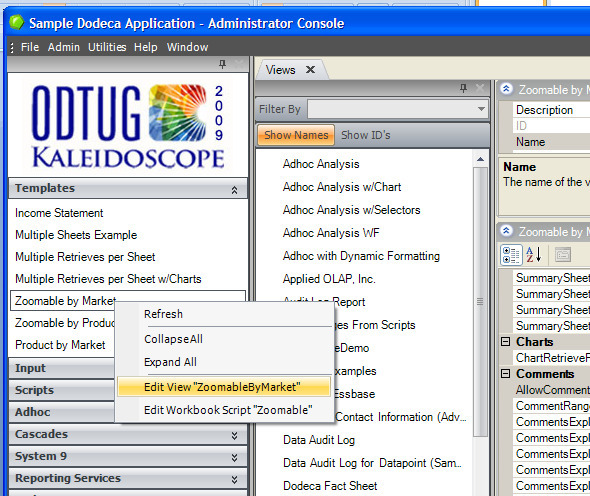
Comments
Comments are supported for the Excel View and Essbase Excel View types.
- BREAKING CHANGE: The OnSheetCommentsRangeHandler has been replaced by the WorkbookViewCommentsRangeHandler. Comment ranges configured to use the OnSheetCommentsRangeHandler will have to be reconfigured to use the WorkbookViewCommentsRangeHandler.
- Comment ranges: One or more comment ranges can be configured for a view. A range can be configured to display comments in the cells of the range, or only link the comments to the cells of the range, presumably using the Comments Explorer to display and edit the comments. Comment ranges can be configured for only one comment per cell, multiple comments per cell, or threaded comments per cell.
- Comments Explorer: A view can be configured to display the new Comments Explorer. The explorer can be configured to allow adding, changing, and deleting comments. It can also be configured to display the values that link the comments to the cell, as well as a configurable context string that can provide information about the value that was in context when the comment was saved.
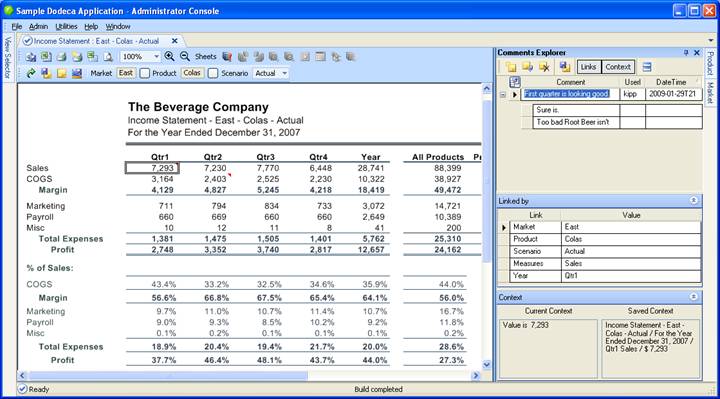
Essbase Excel View
New Setting: The EnforceEssbaseFilterOnOpenViewForDrillthrough setting applies when the DataCellDoubleClickPolicy is OpenViewForDrillthrough. It controls whether the view is opened when the user double-clicks a data cell, but does not have access to the cell based on an Essbase filter. The setting defaults to True, which prevents the drillthrough when the user does not have access to the data cell.
The OpenViewForDataCellToolController also supports an EnforceEssbaseFilter tool argument, which is used to determine whether the tool is displayed on the context menu when the user right clicks on the active cell. (#618)
Fixed Issue: The view throws an exception when a chart sheet is activated. (#609)
Essbase Excel View and Excel View
- The error message previously displayed when the ExcelTemplateBinaryArtifact does not contain an Excel file has been replaced. (#641)
An example of the previous error message:
Unable to build the view. Unable to open Excel file "C:\Documents and Settings\user\Application Data\Applied OLAP, Inc.\Dodeca\4.1.0.0\SAMPLE.GENERAL.Test.1". Unrecognized file type.
Has been replaced with:
Unable to open the Excel template "C:\Documents and Settings\user\Application Data\Applied OLAP, Inc.\Dodeca\4.1.0.0\SAMPLE.GENERAL.Test.1". The file size is 0 bytes. Verify that the binary artifact "Test, Version 1" contains the Excel file.
Essbase Views
- Fixed Issue: When the EssProperties.UseBothForRowDimension is True, any code that attempts to determine the dimension layout for a cell that contains the alias fails. (#621)
Hierarchy Metadata Editor
- New Context Menu options: Expand All Hierarchies, Collapse All Hierarchies. (#627)
- Renamed Context Menu options: Expand All is now Expand All Items, and Collapse All is now Collapse All Items. These options affect the nodes within the active hierarchy. (#628)
- Drag and Drop is now supported for moving and copying hierarchy items and views within a hierarchy or across hierarchies. The context menu options for Cut/Copy/Paste are still supported. (#644)
- Fixed issue: When the Hierarchy Metadata Editor Explorer Bar, which displays the hierarchies, is initially filled or refreshed after a Commit, or when a new hierarchy is added, a box is temporarily displayed in the upper left area of the Explorer Bar. (#625)
Selector ComboBox
- Fixed Issue: When a selector combobox defaults the selection to an item that is not the first item in the dropdown list and the selector list is not configured to validate the selection, and the user then selects the first item, then the default item remains selected when the user exits edit mode. (#617)
SelectorListBox, EssbaseSelectorListBox, and EssbaseSelectorTreeView
- A view’s SelectorDockedControlGroupStyle setting configures the layout of the view’s selector controls as one of the following: tabbed, stacked, sliding headers, or side-by-side. By default, the selector controls are tabbed.
The following screenshots show a few examples of different layouts using the SelectorDockedControlGroupStyle and SelectorDockedControlLocation settings. This first screenshot shows the selectors stacked and docked on the right. The second screenshot shows the selectors side-by-side and docked on the bottom. And, the last screenshot shows the selectors displayed with sliding headers and docked on the right. (#645)
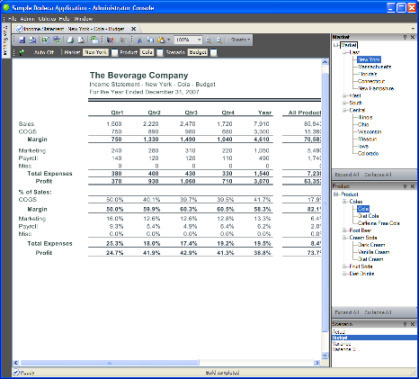

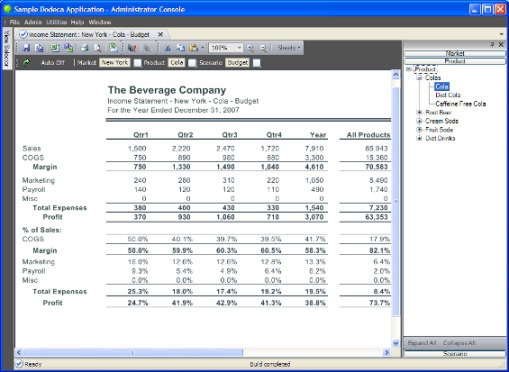
Essbase Selector TreeView
- The ShowFind setting allows the search capability to be disabled by hiding the "Find" area located at the bottom of the control.
- For an EssbaseSelectorTreeView, the members that are generated from a selector list are referred to as the base members. Base members can be added to the tree as either root nodes, which is the default, or as descendant nodes. The behavior is configured using the BaseMemberNodePolicy. The options include AddBaseMemberAsRootNode and AddBaseMemberAsDescendantNode.
When base members are added as descendant nodes, the ancestor nodes are automatically added to the tree. The BaseMemberAsDescendantNode_RootNodeMemberPolicy setting controls which member (or members) is used as the root node. By default, the root node is the dimension. Alternatively, the root node can be based on generation, level, or member name. The options include UseDimension, UseSpecifiedGenNumber, UseSpecifiedGenName, UseSpecifiedLevelNumber, UseSpecifiedLevelName, and UseSpecifiedMemberName. When the policy is UseSpecifiedMemberName, the BaseMemberAsDescendandNode_RootNodeMemberValue setting specifies the member name(s).
The RootNodeExpansionPolicy includes a new option, ExpandAllRootNodesAndPrefilledDescendantNode. All root nodes along with all prefilled descendant nodes are expanded. This option is intended for use when the BaseMemberNodePolicy setting is AddBaseMemberAsDescendantNode and you want the tree to automatically expand to show the base members. This option can also be used when the Prefill setting is True and you want the tree to automatically expand to show all the nodes. Since prefilling the tree and automatically expanding all nodes increase the amount of time the tree takes to display, the total number of members represented by the tree should be taken into account before enabling these options.
For instance, you can limit the members displayed in the tree based on a UDA. For example, with the SelectorListObjectTypeID set to EssbaseReportScript, and the report script defined to return all the Market members that are assigned the Small Market UDA:
<ROW (Market)
<LINK (<UDA (market, "Small Market"))
!
And, with the following SelectorControlProperties settings:
BaseMemberNodePolicy = AddBaseMemberAsDescendantNode
BaseMemberAsDescendantNode_RootNodeMemberPolicy = UseSpecifiedDescendantNode BaseMemberAsDescendandNode_RootNodeMemberValue = 2
RootNodeExpansionPolicy = ExpandAllRootNodesAndPrefilledDescendantNode
The base members are all Small Market members and the root nodes represent the 2nd generation members that are ancestors of Small Markets, which happens to be all the 2nd generation members in the Market dimension. If West, for example, did not contain a Small Market, there would be no root node for West.

This is only one example. The base members can be generated based on an EssbaseDelimitedString, an EssbaseReportScript, an EssbaseMemberQuery, or an EssbaseSQLPallthroughDataSet. (#610)
Workbook Script Metadata Editor
- Opening a workbook script in the editor is much faster. The change resulted in a 90% reduction in load time. (#623)
- Hide Null Arguments — A toolbar button has been added that toggles the display of method argument rows that have no value specified. With these rows hidden, the amount of space used by the Procedures grid is reduced and the tool arguments with a specified value can be reviewed more easily. (#611)
- Bookmarks — With this feature, you can place a bookmark on any row of the Procedures grid. The following buttons have been added to the toolbar: Next Bookmark, Previous Bookmark, and Clear All Bookmark. The bookmarks are saved with the script, which allows the bookmarks to be navigated the next time the script is opened. (#639)
- Column Headers location options — The location of the column headers in the Procedures grid can be changed. By default, the column headers are positioned at the top of the grid. Using the Column Headers dropdown list on the context menu, the location of the headers can be set to Top, Embedded, or None. Setting the location of the column headers to Top or None makes more vertical space available for the procedures, methods, and arguments. (#619)
Column headers positioned at the top of the Procedures grid:
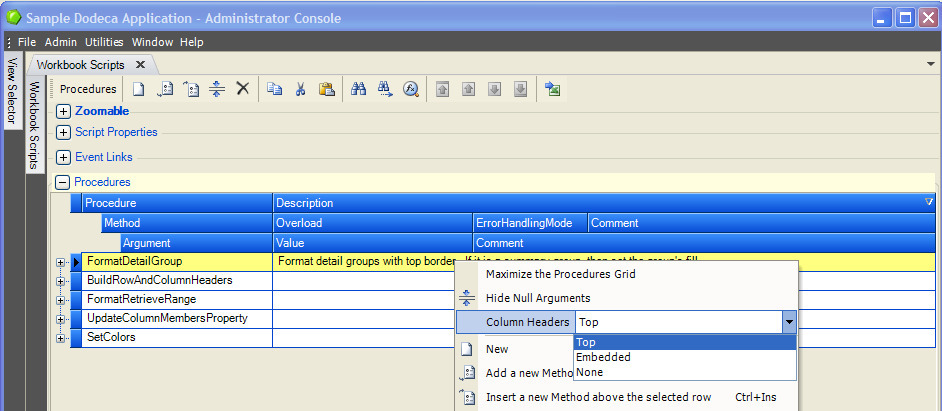
Column headers embedded for each procedure, method, and argument list:
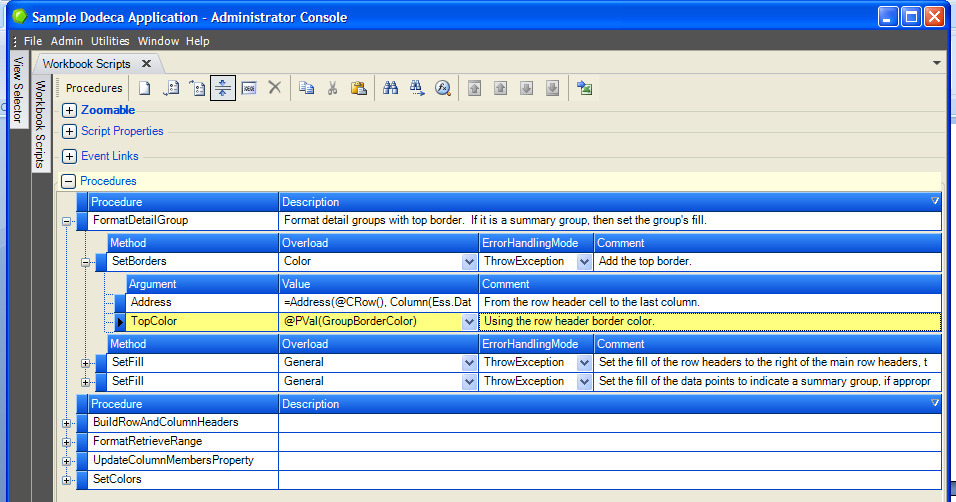
Column headers hidden:
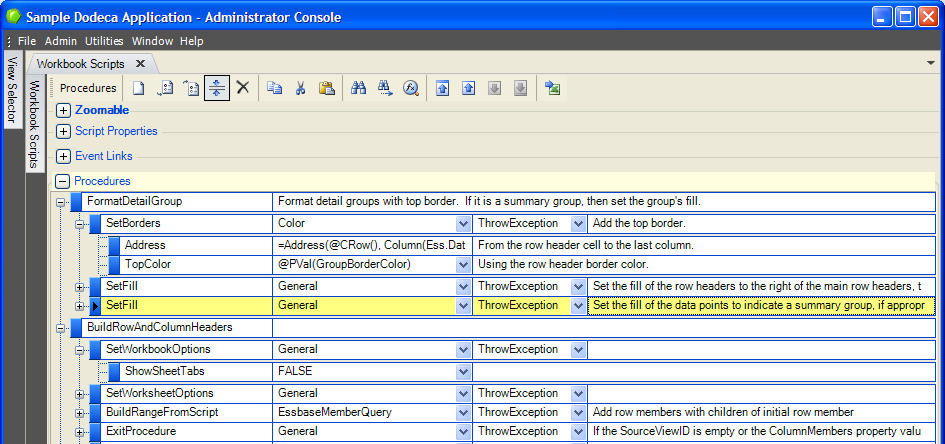
- Add/Insert New Method options — The context menu provides two options for adding a new method relative to the selected row: Add a new Method below the selected row and Insert a new Method above the selected row (#613)
- Export to Excel — Added a View in Excel button to the toolbar, which exports the workbook script to Excel. The Excel file can be used for documentation purposes, etc. (#624)
- Fixed Issue: Error encountered when opening a large script: "SplitterDistance must be between Panel1MinSize and Width - Panel2MinSize." (#620)
Workbook Scripting
- BREAKING CHANGE: Renamed the SetComment method to SetExcelComment. Any scripts that use the SetComment method must be modified to use the SetExcelComment method. (#614)
- BREAKING CHANGE: Renamed AddComment method to SetComment. Any scripts that use AddComment must be modified to use the SetComment with the Add overload. (#616)
- BREAKING CHANGE: Renamed DeleteComment method to SetComment. Any scripts that use DeleteComment must be modified to use the SetComment with the Delete overload. (#615)
- The default values for certain method arguments have been dropped. This change was made to allow for reducing the size of the serialized workbook script by only serializing argument values that have been specified. This should not impact the values of arguments in existing scripts. (#622)
When the following arguments are used in new scripts, the previous default values will have to be entered as required for the desired behavior:
Method.Argument Default Value Was
AddDataCache.Delimiter ;
AddDataCache.ListDelimiter |
AddProperty.DataType string
AddProperty.Initialize TRUE
AddTokensForSubstVars.TokenName [T.<VarName>]
BuildRangeFromScript.BuildRowsOrColumns Rows
BuildRangeFromScript.Delimiter ;
BuildRangeFromScript.EnterNumbersAsText TRUE
BuildRangeFromScript.ListDelimiter |
BuildRangeFromScript.StartCell A1
CancelEvent.Cancel FALSE
ClearRange.Clear All
EssbaseRunCalc.BackgroundCalc FALSE
ExecuteProcedure.MethodCondition TRUE
ExitProcedure.Exit FALSE
SaveWorkbook.IncrementFilename TRUE
SetActiveWorkbook.SpecifyWorkbookBy Index
SetComment.MatchAny FALSE
SetEntry.Error None
SetPageBreak.BreakSetting Manual
SetPageBreak.Orientation Horizontal
SortRange.SortBy All
UnloadWorkbook.SpecifyWorkbookBy Index
- Modified SetColumnWidth and SetColor methods — Removed ColumnByColumn argument and added CellByCell and ReverseOrder arguments. (#633)
- Added ForEach method — This method runs a specified Procedure for each value of the loop. The method has 2 overloads:
- NumberToNumber — For a loop like "for i = start number to end number"
- DataCache — Loops on the values in the specified DataCache
One of the method’s arguments is PropertyName. If specified, each iteration of the loop adds a Property with the specified name and the value of the loop’s current value. As a result, the @PVal() Function can be used to get the value.
Using the DataCache overload, the ForEach method can loop through values from any of the list sources supported by the AddDataCache method, such as DelimitedString, SQLPassThroughDataSet, and EssbseReportScript. (#640)
- Added UpdateSelectorCache method — This is useful when selection changes are used by the script after the view is built or in lieu of building the view, but still need to be cached in order to be used as the default selection by another view. (#634)
- Modified SetWorksheetOptions method — Added the following overloads: FreezePanes, Scroll, and Splitters. (#638)
- Modified AddProperty method — Added data type validation. The value of the property being added is now validated based on the specified data type. An error is thrown if the specified value cannot be converted to the specified data type. (#631)
- Fixed Issue: The AddDataCache throws a "No connection ID" exception on overloads that don’t require an Essbase connection ID. (#635)
- Fixed Issue: Renaming a Procedure does not change the name specified in other Methods that call the changed Procedure. Every occurrence of the Procedure name should be changed automatically. (#637)
The following formula causes an endless loop in the WBS evaluation routine:
=@WSEval("Address(Row(WeekBeginDates), Column(@Selection()))" (#636)
The evaluation routine has been modified to fail after 1,000 iterations as with the following example:
Unable to execute the workbook script procedure "HandleAddResourceButton".
WorkbookScript Method failed:
AppliedOLAP.Dodeca.Windows.WorkbookView.WorkbookViewShowMessageBoxMethod
WorkbookScript: SMARTMPS Input
Procedure: HandleAddResourceButton
Called from: Tool: AddResource; ToolClick
Overload: General
Arguments: [Message==@WSEval("Address(Row(WeekBeginDates),
Column(@Selection()))" ];
Exception:
Error resolving formula.
Argument: Message
Formula: =@WSEval("Address(Row(WeekBeginDates), Column(@Selection()))"
Unable to solve formula after 1,000 iterations.
Dodeca Framework Build 1321
December 12, 2008
Selectors and Essbase Selectors Metadata Editors
- Fixed Issue: The following exception was thrown when the metadata editor was already open and the Admin/Selectors or Essbase Selectors tool was clicked: "The ActiveMetadataInstanceIdAndVersion property is not implemented by SelectorMetadataEditor." (#604)
Starter Kit Metadata
- The Start Kit metadata has been revamped. Several toolbars configurations were removed, and others renamed and edited to remove extraneous tools. (#606)
Workbook Scripting
- EssbaseRunCalc Method — Added BackgroundCalc argument, which controls whether the calculation is run synchronously or asynchronously. (#605)
- Fixed Issue: An error is generated when the ProcedureName is left empty. The Workbook Script Metadata Editor no longer allows an empty procedure name. (#603)
Dodeca Framework Build 1308
December 8, 2008
The versions of SpreadsheetGear and Infragistics NetAdvantage have been upgraded for this build. SpreadsheetGear was upgraded from SpreadsheetGear 2007 (3.1.0.104) to SpreadsheetGear 2008 (4.0.8.104). NetAdvantage was upgraded from NetAdvantage 2007, Vol. 3 to NetAdvantage 2008, Vol.3 (8.3.20083.1009).
NetAdvantage 2008, Volume 3
IMPORTANT: We recommend that you upgrade your toolbar configurations to NetAdvantage 2008, Vol. 3 by exporting and importing your toolbars configurations. To do this, use the Export and Import tools from the Toolbars Configuration Metadata Editor. These tools export and import the native NetAdvantage UltraToolbarsManager layout files. If you have any questions, please contact us.
SpreadsheetGear 2008
SpreadsheetGear is the vendor of the spreadsheet control used by the Essbase view types and the Excel view type.
SpreadsheetGear 2008 includes enhancements to the WorkbookView spreadsheet control, including (but not limited to) the following:
- Added support for chart rendering including the most commonly used chart types and options. Supported chart types include area, bar, column, line, pie, stock and XY scatter. Supported chart type options include multiple chart groups (combination charts), stacked and 100% stacked values, bar gap and overlap, line markers, drop lines, hIgh-low lines, open-close bars, exploded pies, and data point labels. Supported axes options include primary and secondary axes sets, auto and manual scaling, major gridlines and tick marks, reversed axes, and tick label positions. Supported general chart options include chart titles, legends, theme colors, auto colors, number formats and fonts.
*This version of SpreadsheetGear includes support for 2D charts only and does not support axis titles. You may encounter other limitations as this is the first release of SpreadsheetGear that includes charting.*
Refer to the following for additional information:
http://www.spreadsheetgear.com/support/samples/imaging.aspx
An Excel template used by an Essbase Excel view or a generic Excel view can now contain charts, which are retained within Dodeca, and persisted when the view is opened in or saved to Excel.
- Increased the maximum number of rows and columns from 65,536 rows and 256 columns to 1,048,576 rows and 16,384 columns.
Application User Interface
- Dockable windows (such as the view selector, item selectors, and the Comments Explorer) now display drag indicators when dragged. The indicators provide a visual cue that makes it easier for a user to know and indicate where to dock the window being dragged. (#593)
- An application can be configured to display a close button on each View and Metadata Editor window tab. The new application metdata setting, TabbedWindowCloseButtonVisibility, has 4 possible values: Always, WhenSelected, WhenSelectedOrHotTracked, and Never. By default, the setting value is WhenSelectedOrHotTracked. When the setting value is Never, the close button appears at the right of the windows tab area as previously supported. (#592)
Binary Artifact Metadata Editor
Fixed Issue: The "Object reference not set to an instance of an object" exception is raised when attempting to export a binary artifact that represents an Excel template when the Excel file is already open. Now, instead of the exception, a message box is displayed with the following error: "The process cannot access the file '<file name>', because it is being used by another process." (#585)
ClickOnce Deployment
- The Symantec migration tool fails to set proper security in the registry, which results in ClickOnce deployment from completing. (#594)
Please contact us for additional details if you use Symantec and are experiencing any issues with ClickOnce deployment.
- The following error was encountered by a customer upon application launch: "Binary stream '0' does not contain a valid BinaryHeader. Possible causes are invalid stream or object version change between serialization and deserialization." (#596)
When this error is encountered, take the following steps on the client machine:
- Delete the <userhome>\Local Settings\Apps\2.0\* directories. This is where any serialized metadata is stored. Then, test by attempting to run the application.
- If the above does not resolve the issue, repeat Step 1 plus remove the isolated storage caches at <userhome>\Local Settings\Application Data\IsolatedStorage\*. Then, test by attempting to run the application.
- Finally, if not already installed, we highly recommend installing the .NET Framework Version 2.0, Service Pack 1. Test again.
If the error persists, please contact us.
ClickOnce Prep Utility
The ClickOnce Prep Utility now supports the ability to export the setting values, excluding the certificate password and/or thumbprint, to a text file. (#589)
Comments
- Certain comments functionality, like the WorkbookView comment range handler and the Comments Explorer are still under development. Preliminary development can be done with them, but there are known issues. The functionality is expected to be ready in a couple of weeks.
Dodeca Metadata Service
- DDL generation report is now available on the Dodeca metadata service (#587)
Several customers have requested a way to get the DDL for the Dodeca metadata table structure. This capability is now available by going to a web browser and typing in the location of the metadata service* and then selecting the option to generate DDL.
*The format of the metadata service address is:
http://<server>:<port>/dodeca/metadata-service
The DDL generated is based on the database type configured in your hibernate.properties file and includes the DDL to drop an existing schema and create a new schema. It also includes the DDL to update a schema, so you can see changes to the schema definition.
Note: The update schema functionality does not show changes in column widths and thus should be used for informational purposes only.
Essbase Adhoc View
Fixed Issue: If an Adhoc view is opened, but not built, and the user opens the Essbase Options dialog, the dialog is empty. (#600)
Excel Essbase View
Fixed Issue: When an Excel Essbase View is configured with the SelectorsVisibleOnDrillthroughSheet set to False and the user unpins a selector when a template sheet is active, then activates a drill-through sheet, and then reactivates the template sheet, the selector becomes unpinned. (#602)
Import/Export Metadata
- The Import/Export Metadata from/to a Local XML File utility dialogs now display a date format that can be sorted. Previously, the dates could not be sorted, so it was difficult to find metadata artifacts that had recently changed. (#598)
Splash Screen
- Fixed issue: If the user double-clicked on the splash screen to close it at exactly the same time a timer event was being called on the splash screen itself, an exception was raised. (#601)
Tool Controllers
- A tool argument value can now contain a forward slash. (#597)
This issue was reported by a customer who needed to assign a member name that contained a forward slash as the value of a worbook script tool controller argument.
Toolbars Configuration Metadata Editor
The Toolbars Configuration Metadata Editor now supports new utilities: Toolbars Designer and Configure Tools.
The Toolbars Designer supports adding/editing/deleting toolbars and tools, as well as adding and removing tools contained by toolbars and popup menus.
Note: Since views use popup menu tools as context menus, you are able to create and modify context menus.

Accessible from the designer, the Import Standard Tools and Toolbars and the Import Tools and Toolbars from a Toolbars Configuration wizards support importing existing tools and toolbars.
The Configure Tools utility supports the ability to customize configurable standard tools by specifying tool argument values and to configure custom tools by mapping a tool to a tool controller and specifying tool argument values.
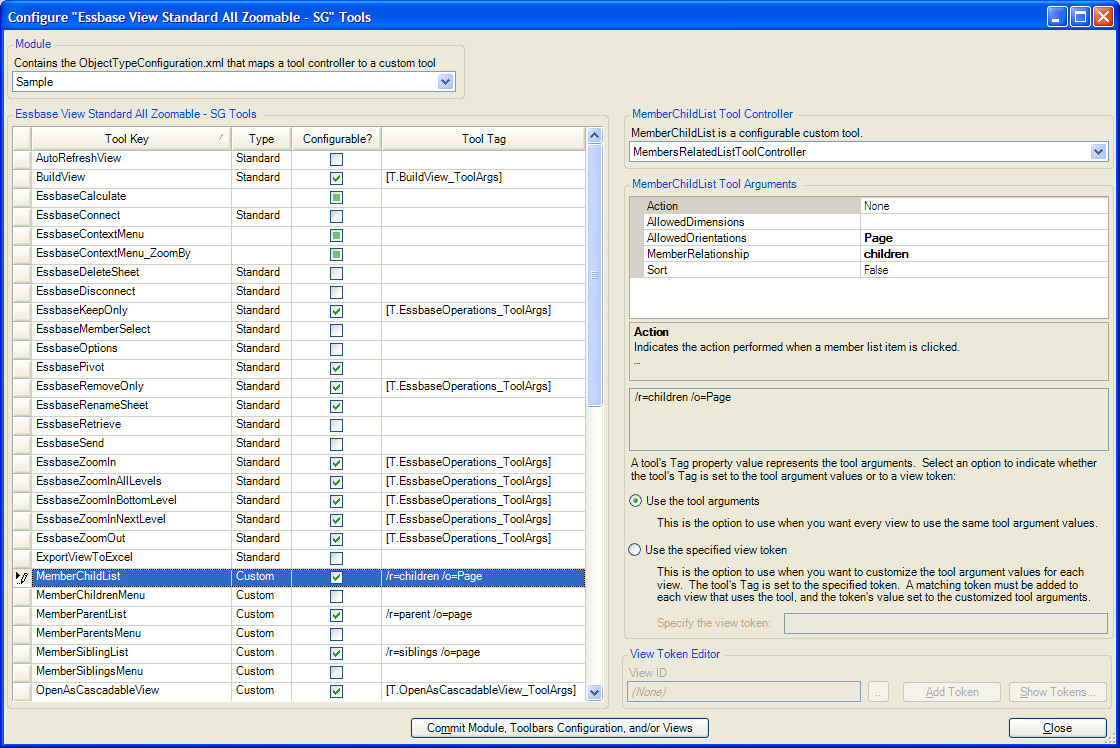
Workbook Script Tool Controller
- In the Tool Arguments Builder and the new Configure Tools utilities, when the WorkbookScriptID property is specified, the ProcedureName and various property name properties can now be selected from dropdown lists. (#584)
Workbook Scripting
- Fixed SetEntry method issue: Could not use functions in the SheetSpec argument or use an address for the Range argument. (#595)
- Fixed issue encountered when the ExcelEssbaseView.BeforeRangeRetrieve event (as well as other Essbase operations "before" events) was cancelled: An exception was thrown with the following message "The retrieve range name "<retrieve range name>" is not an existing retrieve range for the "<sheet name>". (#599)
Dodeca Framework Build 1244
October 28, 2008
Comments Functionality
- Fixed Issue: When prompted to save comments, the working status was not going away when the user selected Cancel. This issue is specific to the OnSheet comment range handler. (#583)
- Fixed Issue: On a two sheet view, with comments on the second sheet, if you selected the second sheet, then selected the first sheet again, and then clicked the Build button, you were prompted for whether or not to save the unsaved comments, even though none had changed. And, if you selected "yes", the comment value from the wrong sheet was used. (#582)
Workbook Scripting
- Fixed Issue with BuildRangeFromScript method: An exception was being thrown by the method regarding a missing Essbase connection for the overload did not support an Essbase connection. (#579)
Tool Arguments Builder
- WorkbookScriptToolController Enhancement: When specifying the settings for a WorkbookScriptToolController, you can select the ProcedureName and each of the various property name settings from a dropdown list of available values based on the workbook script specified as the WorkbookScriptID setting. (#584)
ClickOnce Installation
- Proventia anti-malware software (firewall/virus protection hybrid) blocks a ClickOnce installation.
This issue is encountered on machines with an old version of the Proventia software. A dialog box with a "Details" button is displayed indicating the installation failed. The button is either disabled or, when the button is clicked, an empty document is presented.
The issue can be resolved by upgrading the Proventia software. Please contact us for specific instructions. (#580)
- Conflict between ClickOnce and Kensington Mouseworks causes ClickOnce applications to crash.
The current versions of Kensington Mouseworks have a problem in one of their driver DLL’s that crashes all ClickOnce applications. The issue occurs in a DLL that is loaded with every Windows process, and crashes that process if the executable path is longer than 128 characters. Since the ClickOnce store uses directory obfuscation when storing an application’s files, this issue affects all ClickOnce applications.
The only current workaround is to use Add/Remove Programs to uninstall Kensington Mouseworks. This requires a reboot to restore the minimal drivers Windows needs for mouse input. After the reboot, any advanced functionality provided by the Kensington hardware will not work. (#581)
Dodeca Framework Build 1234
October 17, 2008
Comments Functionality
- Added a new RangeHandlerObjectTypeID option to the CommentRange configuration. The WorkbookView comment range handler implements the usage of script formulas in the new ContextString and KeyItemsString comment properties. With this functionality, comments can be linked to the sheet without using a KeyItems range or a Contexts range. (#571)
Fixed issue: The Comment key items were being deleted when the comment was updated. (#576)
Excel Essbase View
- New Setting: ShowFormulaBarOnDrillthroughSheet (#572)
In addition to the existing ShowFormulaBar setting, the Excel Essbase view now supports a ShowFormulaBarOnDrillthroughSheet, which controls whether the Formula Bar is visible when the active sheet is a drillthrough sheet. The ShowFormulaBar setting now only applies to non-drillthrough sheets.
Excel and Excel Essbase ViewsU
- The ActiveSheetChanged event is now raised when the initial sheet is activated after the template is loaded. (#568)
Workbook Scripting
- The EssbaseRunCalc method now runs on a background thread. (#573)
The view’s toolbars and selectors are disabled while the calculation is running, but the user is able to interact with other views. The view’s status bar displays "Calc running" while the calculation is underway and "Calc completed" when the calculation is done. When the calculation is completed, the workbook script procedure resumes with the next method following the EssbaseRunCalc method.
- Fixed issue in the Workbook Script Metadata Editor where the Commit button was not being enabled when a Procedure name was changed and the Tab button was then clicked. (#570)
Essbase Selector TreeView
- Fixed Issue: When the root node was a non-dimension member, a search would return members that were not descendants of the root node member(s). (#575)
Important
This fix requires a new Essbase serviet, which was previously named ActiveOLAP and is now named dodeca-essbase. Please contact us for a new release of the servlet.
Auto Build Tool Controller
- Fixed issue: If the view’s AutoBuildOnOpen setting was false and the user did not explicitly build the view before changing a selection and the "Auto Build" tool state was On, then the first selection change triggered the first build, yet the view UI remained covered after the build completed. (#569)
Workbook Script Tool Controller
- Fixed issue encountered when a state button tool is mapped to a workbook script tool controller and the ValuePropertyName tool argument is specified. The workbook script property specified as the value property was not being updated when the state button’s checked state was toggled by the user. (#578)
Tool Controller Debug Tool Argument
- The following tool controllers now support a Debug tool argument:
OpenViewForDataCellToolController
OpenViewForMemberCellController
All the Essbase operations tool controllers, such as KeepOnlyToolController, ZoomInToolController, etc.
The argument is a Boolean that defaults to false. To turn on debugging, specify /x=true in the tool arguments string.
For these tools, the context menu tool visibility is set based on whether the selected cell(s) passes the criteria defined by the tool arguments. If debugging is on, a message box is displayed after the right button is clicked and before the context menu is displayed. The message box contains the tool argument values, information about the selected cell(s), and diagnostics.
For example, the message box below was displayed by the "Open View for Member Cell" tool controller that was configured to display the tool only when Market members are selected. As indicated, only one of the 3 selected cells qualified, since one of the cells was a Year, and another a Scenario.

Dodeca Framework Build 1216
October 1, 2008
Manage Saved View
A status bar has been added to the Manage Saved View dialog. When a view is opening, the message "Opening <view name>" is displayed in the status bar. Typically, opening a saved view happens so quickly that the message is not seen, but when there is a delay, the message provides a visual cue to the user that something is happening. (#565)
AutoBuild Tool
The AutoBuild tool is a state button tool that, when On, automatically builds the view when a selection changes. (#555)
Excel View and Essbase Excel View
The ActiveSheetChanged event is raised when the Excel template is loaded.
Excel Essbase View
Fixed an issue with the datapoint UDA-based member filtering. This issue was introduced with the last build. (#560)
Workbook Scripting
- The Formula Editor dialog now shows function documentation. (#558)
- AddTokensForSubstVar Method: Added Username and Password arguments. (#563)
- ActiveSheetChanged EventLink: For an Excel View and Essbase Excel View, the ActiveSheetChanged event is raised when the view’s template is loaded. The activated sheet is the template’s active sheet. This allows any logic associated with the ActiveSheetChanged EventLink to be executed for the template’s initial active sheet. (#568)
- New Method: SetCover
The SetCover method controls whether the view content is shown or hidden. (#557)
- New Method: SetToolbarVisible
This method can be used to show or hide a specified view toolbar. The tool arguments include a ToolbarKey and Visible value. This method allows you, for example, to control whether any given toolbar is visible based on the active sheet by calling the method from the ActiveSheetChanged event link. For instance, with an ExcelEssbaseView, you may want a particular toolbar to be displayed only when the active sheet is a drillthrough sheet. (#566)
- New Function: EssConnectionPropertyValue, @EssConnPValue(ConnID, PropertyName)
This function returns an Essbase connection’s property value given the connection ID and the property name. (#556)
New Function: ActiveSheetName, @ASheet()
This function returns the name of the active sheet. (#561)
New Event Links: Before/AfterRangeSend
These events are only applicable to an ExcelEssbaseView. (#567)
Previously, the Before/AfterSheetSend events were raised for each send range. With this build, these events are raised only once for a sheet and the Before/AfterRangeSend events are raised for each send range.
The Before/AfterSheetSend event property is SheetName.
The Before/AfterRangeSend event properties are SheetName and RangeName.
IMPORTANT: If you are currently using the Before/AfterSheetSend event links, you may want to use the Before/AfterRangeSend event links instead depending on whether the associated logic should be executed for each send range or only once for the sheet.
- Workbook script error messages now include the script ID. (#562)
- Fixed the OpenView method issue that raised the following exception: "Unable to execute the workbook script procedure <procedure name>. Collection was modified; enumeration operation may not execute." The issue only occurred when a workbook script tool controller called the OpenView method in a procedure in the view’s workbook script instead of a separate workbook script. (#559)
- Resolved issues encountered with the Essbase-related methods that support the EssbaseConnectionID, Username, and Password arguments. The connection, username and password that are used by the method are determined as follows:
Arguments: No EssbaseConnectionID specified; No Username/Password specified.
Behavior: The view’s connection is used. The current username and password associated with the connection are used. This could come from the "phantom" username and password stored in the connection’s metadata or the username and password that the user may have already entered. If no username and password is associated with the connection, the user is prompted.
Arguments: No EssbaseConnectionID specified; Username/Password specified.
Behavior: The view’s connection is used. The specified username and password arguments are used for the connection.
Arguments: EssbaseConnectionID specified; No Username/Password specified.
Behavior: The specified connection is used. The current username and password associated with the connection are used. This could come from the "phantom" username and password stored in the connection’s metadata or the username and password that the user may have already entered. If no username and password is associated with the connection, the user is prompted.
Arguments: EssbaseConnectionID specified; Username/Password specified
The specified connection, username, and password are used. (#564)
- Fixed issue with the Save View As and Save View tools remaining disabled when a script calls the BuildView method in a SelectorSelectionChanged event link. (#554)
Dodeca Framework Build 1201
September 17, 2008
Session Caching (#547)
The session cache is a client cache that is used to store data, such as resolved selector lists and SQL pass-through datasets, for the duration of a session. The cache uses the same backing store used for application caching. Session caching improves performance by reducing the number of client to server requests. It is enabled or disabled for an application by the application’s SessionCachingEnabled metadata setting. It is enabled by default.
When session caching is enabled for an application, the administrator controls whether or not an individual SQL pass-through dataset or selector list uses the session cache through the metadata instance’s SessionCachingEnabled setting.
By default, a SQL pass-through dataset’s SessionCachingEnabled setting is False. When the query results are data-driven (i.e. when the query results are likely to change over the course of a session), then session caching should be disabled.
Please note that a SQL pass-through dataset that contains a tokenized query does not necessarily imply that the results are data-driven. When the query is tokenized, the cache can contain multiple occurrences of the dataset, each representing a unique post-'token replacement' query statement.
Session caching is also supported for Essbase selector lists:
The EssbaseDelimitedString, EssbaseMemberQuery, and EssbaseReportScript selector list items are optionally cached based on the selector list’s SessionCachingEnabled setting. By default, session caching is enabled for an EssbaseDelimitedString and EssbaseMemberQuery, but is disabled for an EssbaseReportScript. Session caching should be disabled for an EssbaseReportScript selector list when the members generated by the report are data-dependent, such as when the script suppresses missing.
The EssbaseSQLPassthroughDataSet selector list items are optionally cached based on the associated SQL pass-through dataset’s SessionCachingEnabled setting.
When session caching is enabled for an Essbase selector list and the selector list’s SelectorControlObjectTypeID is set to EssbaseSelectorTreeView, then the session cache is also used to store outline information that is used to populate the treeview.
Generally speaking, session caching should be disabled for any selector list that represents a dimension whose member hierarchy changes frequently. However, when a dimension is fairly static, enabling session caching is an excellent way to improve overall performance.
Session caching is also used to store Essbase member information that’s retrieved for the following:
- An EssbaseSelectorTreeView’s member tips when the MemberToolTipContentOptions include UDAs, Comment, and/or Formula
- An ExcelEssbaseView when member filters are defined by the DataCellDoubleClickMemberFilters
- An OpenViewForDataCellToolController when member filters are defined by the MemberFilters tool argument
- A workbook script that uses any of the member functions, such as MemberAlias, MemberChildCount, MemberDImension, etc.
- A workbook script that uses any of the DataPoint functions, such as DataPointDimGeneration, DataPointDimLevel, etc.
An administrator can view the contents of the session cache using the Cache Viewer tool, which is located in the default admin toolbars configuration’s Admin menu.
Workbook Scripting
- New Event Link: BeforeSelectorListItemsResolved (#552)
- New Event Link: BeforeInitializeUI (#549)
- New Functions: @IsDataCell() and @IsMemberCell() (#550)
Save View Tool
- When a saved view’s AfterBuildCaption is assigned a value, the value is used as the view’s caption even when the value is different than the saved view’s name. This is because the AfterBuildCaption is typically tokenized in order for the view’s caption to reflect the current selections. Then, when the user re-saves the previously saved view by clicking the Save View button, if the view’s caption is different than the saved view’s name, the user is prompted and can choose to update the existing name to the current caption, or use the existing saved name, or specify another name. (#548)

View Metadata Editor
- Resolved the issue that prevented an administrator from being able to navigate to the Binary Artifact Metadata Editor by clicking an Excel View’s ExcelTemplateBinaryArtifact setting with the right mouse button and selecting the "Open Binary Artifacts" or "Edit <Excel template binary artifact ID>" option from the context menu. (#553)
- Resolved the issue that prevented an administrator from being able to navigate to the Workbook Script Metadata Editor by clicking an Excel View’s WorkbookScriptID setting with the right mouse button and selecting the "Open Workbook Scripts" or "Edit <workbook script ID>" option from the context menu. (#553)
Dodeca Framework Build 1187
September 8, 2008
ClickOnce Prep Utility
- A new setting, ApplicationLaunchMode, has been added to the ClickOnce Prep Utility. After installing the SmartClient application on a client, the setting controls whether or not the application can be started 1) from either the URL or the client’s start menu OR 2) from the URL only. (#542)
The application launch mode LaunchFromURLOnly is especially useful when there are multiple applications installed on a client machine that are defined within the same tenant. Since the tenant, application ID, and path are specified by the URL’s query string parameters, using the link ensures that the correct application is started.
Excel Essbase View
- Comments — Fixed issue where a CommentRange’s CommentType could not be changed to OnSheet. (#543)
- Comments — Modified to raise the Before/AfterCommentSetup events only when there are CommentRanges defined. (#541)
- When the AllowEssbaseOperationsOnRetrieveRange is True, the Essbase operations-related tools, including Zoom In/Out, Remove/Keep Only, and Pivot, are disabled when the active sheet contains multiple retrieve ranges. (#540)
- When retrieving a sheet, tokens are now replaced before the BeforeSheetRetrieve event is raised. (#544)
The event sequence when building an Excel Essbase View is as follows:
BeforeBuild
BeforeWorkbookClose
AfterWorkbookClose
BeforeTemplatePullToClient
AfterTemplatePullToClient
BeforeWorkbookOpen
AfterWorkbookOpen
For a cascade view
BeforeCascadeSheetsBuild
If the SummarySheetAdd setting is true
BeforeCascadeSummarySheetBuild
End If
AfterCascadeSheetsBuild
End For
BeforeWorkbookRetrieve
For each sheet
BeforeSheetReplaceTokens
AfterSheetReplaceTokens
BeforeSheetRetrieve
For each retrieve range on the sheet
BeforeRangeRetrieve
AfterSheetRetrieve
End For each
AfterSheetRetrieve
End For each
AfterWorkbookRetrieve
If the view has CommentRanges
BeforeCommentsSetup
AfterCommentsSetup
End If
AfterBuild
Dodeca Framework Build 1183
September 3, 2008
ClickOncePrepUtilityForm
- The default UpdateMode has been changed from Background to Foreground. (#539)
Comments
- Added new comment range CommitPolicy option: User. The new option can be used in conjunction with the new Comments Save tool to allow the user to explicitly save comments instead of the comments being automatically saved on input. When the CommitPolicy is set to User, the comment edits are buffered until the user clicks the Comments Save tool or until the view is built, refreshed, or closed, at which time the user is prompted for whether or not to save the unsaved comments. (#536)
Workbook Scripting
- Fixed issue where the methods that support an EssbaseConnectionID, Username, and Password arguments were not using the specified Username and Password. (#537)
EssbaseLoginDialog
The EssbaseLoginDialog, which can be specified as an Essbase view’s EssbaseLoginServiceObjectTypeID, now retains the last valid specified username. The value is used as the default when the login dialog is displayed. The value is cached and retained across sessions. (#535)
View Selectors
In Build 1173, new behavior was implemented that allowed for multiple hierarchies to be merged in the view selector. The ViewSelectorTree did not handle the merging of duplicate hierarchy items correctly (i.e. when the same ID is used for a hierarchy item in different hierarchies.) This has been corrected. Now, a hierarchy item with an ID that is included in multiple hierarchies will only appear once in the view selector. The location and parent of the hierarchy item is determined by the first hierarchy in which it is included. The hierarchies are added to the view selector in the same order as they appear in the HierarchyToRoleMapping collection. (#538)
Excel Essbase View
- The Essbase operation tools (Zoom In/Out, Remove/Keep Only, and Pivot) are disabled when the active sheet contains multiple retrieve ranges even when the AllowEssbaseOperationsOnRetrieveRange setting is true. Performing these operations using the mouse (i.e. double click for retrieve and right mouse drag for pivot) is also disallowed. (#540)
Dodeca Framework Build 1173
August 26, 2008
Database structural changes
Three changes were made to the database structure in this release which will require an update to the database schema. Two of the changes were made to accommodate longer hash key values necessary to comply with the government 'FIPS' ("Federal Information Processing Standards") standards required for Federal government computing systems. Dodeca formerly used MD5 hashing algorithms and has been updated to the FIPS-compliant SHA-1 standard. The changes are:
| Table | Description of Change |
|---|---|
BINARY_ARTIFACTS | The CHECKSUM column width was changed from '50' to '128'. |
COMMENTS | The COMMENT_KEY_HASH column width was changed from '32' to '128'. |
COMMENT_ATTACHMENTS | The MIME_TYPE column was added to the table. |
The changes to the hashing algorithms will require that customers with existing metadata run a one-time update to their metadata using our new HashcodeUpdateUtility. This command-line utility will convert the values in the BINARY_ARTIFACTS.CHECKSUM and COMMENTS.COMMENT_KEY_HASH columns from MD5 to SHA-1 hash codes. We expect to help our customers make this change via webcast. IF YOU ARE AN EXISTING CUSTOMER WITH EXISTING METADATA, DO NOT INSTALL THIS BUILD UNTIL YOU DISCUSS THIS CHANGE WITH US AND YOU HAVE BACKED UP YOUR EXISTING DATABASE INCLUDING METADATA AND COMMENTS.
User Audit Report
The Dodeca metadata service now has a User Audit report. This report can help you manage your license compliance and can also help you determine who is using your system. To run the report, open a browser instance and type in the location of your metadata service (ex. 'http://<server>:<port>/dodeca/metadata-service'). You can then select to run the report for a specific tenant code or for all tenant codes.
Hibernate Properties
The C3P0 Connection Pool settings have been changed in the hibernate.properties file. The default values were increased for hibernate.c3p0.max_size, hibernate.c3p0.min_size, and hibernate.c3p0.acquire_increment to 100, 10, and 5, respectively. (#530)
New Caching Configuration Options (#518)
Two new configuration options were added to the app.config file to support differing needs for caching user settings at runtime.
DataDirectoryBackingStore
The DataDirectoryBackingStore was added to support local storage that uses FIPS compliant algorithms for hashing and encryption. It is also a good choice for customers who do not want to use .NET isolated storage. Further, this backing store is a good choice for customers who would like to encrypt their user settings using FIPS compliant TripleDES encryption. This backing store stores settings by creating files in the ClickOnce Data Directory. To configure the DataDirectoryBackingStore, follow these steps before building your deployment:
- Locate the AppliedOLAP.Dodeca.SmartClient.exe.config.deploy file in your DODECA_HOME\staging\smartclient\4.1.0.0 directory. Note: The filename may be different if you have previously renamed your exe using the ClickOncePrepUtilityForm.
- Open the file in a text editor.
- Locate the backingStores section of the xml and comment out entire <add> node with the name attribute "Isolated Storage".
- Uncomment the entire <add> node with the name attribute " Data Directory Cache Storage ".
- In the <cacheManagers> node, find the <add> node with the attribute name="Cache Manager". In this node, change the attribute value for the backingStoreName from "Isolated Storage" to "Data Directory Cache Storage".
DataBackingStore
The DataBackingStore was added to support storage of user settings in a SQL Server database. It is a good choice for customers who would like to have their settings be persisted across multiple computers. It is also the backing store that is supported when using Citrix server in a distributed server farm environment. This backing store stores settings in a database table in a SQL Server database. To configure the DataDirectoryBackingStore, follow these steps before building your deployment:
- Locate the AppliedOLAP.Dodeca.SmartClient.exe.config.deploy file in your DODECA_HOME\staging\smartclient\4.1.0.0 directory. Note: The filename may be different if you have previously renamed your exe using the ClickOncePrepUtilityForm.
- Open the file in a text editor.
- Locate the backingStores section of the xml and comment out entire <add> node with the name attribute "Isolated Storage".
- Uncomment the entire <add> node with the name attribute "Relational Cache Storage".
- In the <cacheManagers> node, find the <add> node with the attribute name="Cache Manager". In this node, change the attribute value for the backingStoreName from "Isolated Storage" to "Relational Cache Storage".
- Find the node <dataConfiguration> and uncomment it. Note the defaultDatabase attribute value is "CachingConnection".
- Find the <configSections> child <add> node with the name attribute equal to "dataConfiguration" and uncomment it.
- Find the node <connectionStrings> and uncomment it if necessary.
- Find the <connectionStrings> child <add> node with the name attribute equal to "CachingConnection". Adjust the accompanying connectionString attribute to be a valid .NET connection string to the database where you want to store the settings.
- Locate the DODECA_HOME\docs subdirectory and find the CreateCachingDb.cmd command file and the CreateCachingDatabase.sql file.
- Edit the CreateCachingDb.cmd file and replace the --S parameter with the name of the server you specified in the connection string above. Save and close the cmd file.
- Doubleclick on the CreateCachingDb.cmd file to execute the sql script that builds the necessary tables.
After these steps are complete for the respective backing store, save and close the .config file. Run the ClickOncePrepUtilityForm and generate a new deployment. When a user installs Dodeca on their machine, the new setting storage mechanism will start.
Note: We do not support conversion of previously stored local settings to use a different backing store. Further, as the metadata service location, tenant and application keywords were previously stored solely in the backing store, if the user was previously deployed from a URL, it is mandatory for that user to reinstall from a URL in order to have those values available for processing. If they initially attempt to launch/update from a menu shortcut, they may see an error indicating the tenant or other key pieces of information is missing.
Note: Beginning with this build, a backup copy of the the metadata service location, tenant and application keywords, which are essential to Dodeca startup, are also stored in the client deployment metadata subdirectory. As these values are passed on the querystring upon the original installation and startup, the backup copy of these values are stored unencrypted.
ClickOncePrepUtilityForm
The ClickOncePrepUtilityForm now uses the data directory backing store (instead of isolated storage) to store saved settings. If you previously saved settings, you will need to re-enter and re-save the settings. (#531)
Application Setup Utility
The Application Setup Utility also now uses the data directory backing store (instead of isolated storage) to store saved settings. If you previously saved settings, you will need to re-enter the settings.
Session State
The application’s size, location, and whether the application is maximized is now retained between sessions and restored on startup. (#497)
View Selector
- Support for multiple hierarchies (#515)
Previously, when a view selector’s HierarchyToRoleMapping setting was used to map a hierarchy to a role, the first hierarchy that the authenticated user qualified for (based on role membership) was presented in the view selector. Since a user may actually have several roles (i.e. belong to several groups), the functionality has been changed in this build to display all the hierarchies that the user qualifies for.
The ViewSelectorExplorerBar merges multiple hierarchies based on hierarchy item ID’s.
With the ViewSelectorTree, the HierarchyRootNodeDisplayPolicy setting controls whether the root nodes represent the hierarchies OR represent the top level items of each hierarchy. The policy options include the following:
- Hierarchy — A root node is displayed for each hierarchy.
- TopLevelItems — The root nodes represent the top level items of each hierarchy. Hierarchy items are merged based on hierarchy item ID’s.
- TopLevelItemsForSingleHierarchy — When a single hierarchy is presented by the tree, the root nodes represent the hierarchy’s top level items. When multiple hierarchies are presented by the tree, a root node is displayed for each hierarchy. This is the default setting.
- Support for hierarchy item filtering (#500)
The ability to filter hierarchy items before a hierarchy is displayed is now supported through extensibility by way of a custom filter service. This allows an application to restrict which hierarchy items are presented based on the user’s access. The ViewSelectorExplorerBar and ViewSelectorTree settings now include a HierarchyItemsFilterObjectTypeID setting, which identifies the service.
Please contact us for more information about how to implement a hierarchy item filter service.
- Support locking the view selector in the default docked location (#512)
A new application setting, ViewSelectorLocked, allows an administrator to prevent a user from moving the view selector from the default docked location, which is specified by the ViewSelectorDockedLocation setting.
Selectors
- Fixed an issue with the Selector TreeView control (#513)
When the control was undocked and then the Find section was expanded, the Search results covered the "Select" button.
- Support locking a selector treeview or listbox control in the configured docked location (#511)
The view setting SelectorControlDisplayMode now supports a new option, LockedDockedControl, which can be used to prevent a user from moving the treeview or listbox selector from the default docked location, which is specified by the SelectorControlDockedLocation setting.
- Floating selectors are automatically hidden/displayed when the view is deactivated/activated (#526)
Workbook Scripting
- Workbook Script Tool Controller (#508)
Previously, multiple WorkbookScriptToolController instances could only share the same workbook script if all the instances used the view’s workbook script. This required that the logic for the workbook script-based tools be embedded in the view’s workbook script (or be included as an external script in the view’s workbook script.)
With this build, workbook script-based tools that provide related functionality, such as tools that support spreading, can use the same workbook script instance without having to use the view’s workbook script. This is handled automatically when the /s tool argument is used and the specified ID is a different ID than the view’s WorkbookScriptID setting.
A WorkbookScriptToolController can still use the view’s workbook script by not including the /s tool argument or by using the /s tool argument and specifying the same value as the view’s workbook script ID.
- New Event Link: AfterInitializeUI (#505)
The AfterInitializeUI event link is raised after the view UI is initialized.
This event link was added to address a customer’s specific requirement, which was to be able to set a dependent selector’s selection to null when the user changes the "depended on" selector’s selection, but only after the dependent selector’s default selection was set based on the default selection policy. The AfterInitializeUI event link can be used to add a view token that sets the dependent selector’s token to "null". When the "depended on" selector’s selection changes, the dependent selector will have a null selection.
This event link will be useful whenever you need to insert logic after the view’s user-interface is initialized, but before the view is actually displayed.
- New Event Links: BeforeCommentsSetup / AfterCommentsSetup (#516)
- New Event Links: BeforeOpenInExcel / AfterOpenInExcel (#519)
- New Event Links: BeforeSaveAsExcel / AfterSaveAsExcel (#519)
- New Event Links: ClipboardPasting / ClipboardPasted (#529)
New Event Link: EssbaseExceptionOccurred (#493)
This event link allows a workbook script to intercept an Essbase error and, for example, display a message box. The event properties include an ErrorCode, Message, and Details.
- New Method: OpenView (#496)
- Modified Workbook Script Editor to always show drop-down buttons on cells that have lists. (#495)
- Modified Workbook Script Editor to continue to display tooltips while the mouse is hovering. In other words, the tooltips do not disappear after 5 seconds. (#528)
- Modified SetViewStatus method to throw an exception if an image is not specified. (#494)
- Modified SortRange method to use the SortRangeAddress argument. (#517)
- Optimized pasting of rows in very large scripts. Also, the first procedure in the Procedures section is automatically scrolled to when the script is loaded. (#499)
- Fixed an issue with the EssbaseRunCalc method. (#522)
When the ConnectionID argument was specified, the script was not using the username and password settings that were configured by the connection’s metadata. Instead, the script was using the view’s Essbase connection’s username and password.
With this build, the script’s behavior is as follows:
If the Username and Password script arguments are specified, the specified values are used. Otherwise, if the Essbase connection’s metadata Username and Password settings are specified, the specified values are used. Otherwise, the username and password of the view’s connection are used.
Saved Views
- Duplicate saved view name detection (#514)
The Save View As command now checks to determine whether the name specified by the user is the name of another view previously saved by the user. If so, the user is prompted as follows: "The saved view name "<view name>" already exists. Do you want to replace the existing saved view?" If the user clicks "Yes", the existing saved view is replaced with the current view.
In addition, the saved view name is now always used as the view caption even when the view’s CaptionAfterBuild setting is specified.
SQLPassthroughDataSet Enhancements (#503)
- New Timeout property
The SQLPassThroughDataset has a new Timeout property that is used to limit the amount of time a query can run on the server. The property value is configurable for each distinct SQLPassthoughDataSet object and is expressed in seconds. A value of 0 or less indicates no timeout will be set.
- ConnectString Format
The ConnectString property has been changed to make it easier to specify. Previously, the ConnectString was specified using a space delimited format and was sensitive to the insertion of extra spaces. The format has been changed to support newline delimiters between different properties with a space delimiter between the property name and the property value. Here is an example of the new format:
hibernate.dialect org.hibernate.dialect.SQLServerDialect
hibernate.connection.username sa
hibernate.connection.password password
hibernate.connection.driver_class com.microsoft.sqlserver.jdbc.SQLServerDriver
hibernate.connection.url jdbc:sqlserver://localhost;DatabaseName=AdventureWorks;SelectMethod=cursor
This format is the format used in the hibernate.properties file and makes it possible to use properties that do not have a name/value pair such as 'hibernate.jdbc.wrap_result_sets'.
The SQLPassthroughDataSet functionality continues to support the old format
ConnectString but we recommend customers update their ConnectString definitions to use the new format.
- Tokenized Connect String (#509)
The connect string can be tokenized. Token replacement is performed before the query is executed.
- Column Mapping
The column names returned by a query, along with their data type, are now automatically mapped from the resultset. Column definitions are no longer necessary nor are they used if created in the metadata editor.
- ConnectString Encryption
The ConnectString property is now encrypted using the TripleDES encryption algorithm when it is transported across the network. This change was made to prevent passwords from being transmitted across the network in clear text format. Note: The encryption was also implemented in the older SQLPassthroughDataSetService.
- Connection Caching
The server initializes connections using a Hibernate SessionFactory object. In the previous implementation of the SQLPassthroughDataSet service, a SessionFactory was created for each call to the service which was inefficient. The service has been updated to cache the SessionFactory on the server. The SessionFactory cache is keyed on an SHA-1 hash of the encrypted ConnectString. The new connection caching functionality enables support for Hibernate connection pooling for SQLPassthroughDataSet functionality which should increase performance.
Backwards Compatibility Note:
The original SQLPassthroughDataSet service implementation has been retained on the server but is scheduled to be removed after existing customers confirm they have updated their SQLPassthroughDataSet definitions. To enable the older SQLPassthroughDataSet service on the server, find the following line in the dodeca.properties file:
dodeca.metadata.service.SQLPassthroughDataSet=com.appliedolap.dodeca.server.metadata.selectors.SQLPassthroughDataSetService2
and replace it with:
dodeca.metadata.service.SQLPassthroughDataSet=com.appliedolap.dodeca.server.metadata.selectors.SQLPassthroughDataSetService
Open In Excel Tool (#510)
Previously, when a view was opened in Excel, the view’s name was used as the Excel filename. In this build, the view’s caption is used as the Excel filename.
Page Setup Tool (#524)
The non-PageSetup nodes are no longer displayed and the caption is set to "Page Setup'. Also, the Page Setup node for the active worksheet is automatically selected.
New Tools
- About Dodeca Application Framework (#501)
The About tool has been added to the default Administrator toolbars configuration. It displays the version and build number.
- Cut, Copy, and Paste (#523)
The tools can be added to a toolbar and context menu.
The Paste options include All, All (except cell borders), Formats, Formulas, Formulas and Number Formats, Values, Values and Number Formats
- Send To Mail Recipient (As Excel Attachment) (#521)
The tool saves the view’s workbook as an Excel file and adds the Excel file as an attachment to an email that is then displayed using the default email client UI. The user can add recipients and edit the email before sending. The tool has been added to the appropriate Sample tenant’s view toolbars configurations.
- Spreadsheet Formatting Tools (#525)
The following formatting tools are now supported: AlignLeft, AlignRight, Bold, Borders (Popup menu), BordersList (12 different borders buttons), Center, CommaStyle, CurrencyStyle, DecreaseDecimal, DecreaseFontSize, DecreaseIndent, Explorer, FillColor,
Font, FontColor, FontSize, IncreaseDecimal, IncreaseFontSize, IncreaseIndent, Italic,
MergeAndCenter, PercentStyle, Underline
- Print All Tool (#507)
The Print All tool prints all the worksheets in the workbook.
ExcelEssbaseView
- Fixed issue encountered with a cascading view when a member name contained an apostrophe. The view threw an exception during retrieve. Member names (as well as template sheet names) that contain an apostrophe are now supported.
Dodeca Framework Build 1110
July 18, 2008
Essbase Selector Metadata Editor
A default selector list can now be automatically created for each new selector when committed. The default selector list ID is <SelectorID>_Default, such as Market_Default. The default control is an EssbaseSelectorTreeView and the default list is an EssbaseDelimitedString. The SelectorListProperties are set as follows:
- DefaultSelectionPolicy = LastUsedItem
- DelimitedString = <Selector.Source>, which is the dimension name.
- NullSelectionText = "Select a(n) <Selector Source>
Metadata Editors
For the metadata editors that display properties in a property grid, any property that represents another metadata instance can be right clicked to display a context menu that allows the metadata editor (associated with the instance’s type) to be opened.
For example, in the View Metadata Editor, if an Excel Essbase View is selected, clicking the WorkbookScriptID property name with the left mouse button (to activate the item) and then clicking the right mouse button displays a context menu. If the WorkbookScriptID is set to the ID of a workbook script, such as MyWorkbookScript, the context menu contains an "Edit MyWorkbookScript" item. Clicking the item opens the Workbook Scripts Metadata Editor (or activates the editor if already open) and the MyWorkbookScript instance is automatically selected. If the ID is not assigned a value, the context menu displays "Open Workbook Scripts", which also opens or activates the Workbook Script Metadata Editor, but without automatically selecting an instance.
Import Essbase Connections
A new utility is available that supports importing multiple Essbase Connections. The Import Essbase Connections utility is available from within the Essbase Connections Metadata Editor and can be launched from Admin / Quick Start Utilities and from the Quick Start task pane, which can be displayed from the Help menu.
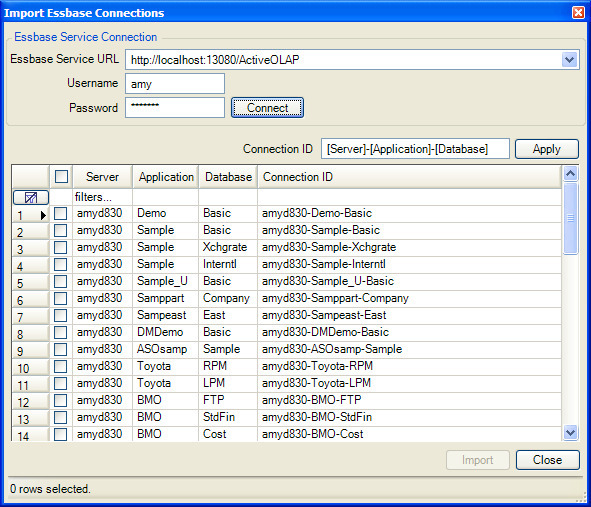
Import Dimensions
The Import Dimensions utility, which is available from within the Essbase Selectors Metadata Editor, can now be launched from Admin / Quick Start Utilities and from the Quick Start task pane, which can be displayed from the Help menu.

Selector and Selector List Changes and Bug Fixes
- When an Essbase selector treeview’s default selection is a member that has shared members, the handling of the default selection has changed. When the selector is configured to allow only a single item to be selected, the base member is selected (instead of the first matching member). When the selector is configured to allow multiple selections, only the base member is selected (instead of the base member and all shared members.)
- Previously, a "dependent" selector would attempt to restore the previous selection when the "depended on" selector’s selection changed. If unable to do so, the default selection would be used. Now, the selector does not attempt to restore the previous selection, and the default selection, if any, is always used. It is still recommended that the selector list assigned to the "dependent" selector be configured to validate the default selection.
- Selector TreeView and ListBox docked controls would sometimes automatically re-display when the active sheet changed even though the control was explicitly closed by the user (by clicking the "X" button.) Now, when a selector control is closed by the user, it remains closed until the user clicks the "Show" button in the selector tool.
- The issue with tokenized delimited string selector lists not being resolved has been fixed.
Workbook Script Tool Controller
The workbook script tool controller now supports a Tool Caption argument.
Selector Control Dialog
When a view’s SelectorControlDisplayMode is set to ModalDialog, the dialog’s location centered within the bounds of the application instead of relative to the selector tool. The size of the dialog has also been made larger.
Import View from Excel
The issue with the import of a view from Excel failing when an optional selector has a null selection when the view was exported has been fixed.
Dodeca Framework Build 1088
June 30, 2008
Essbase Connections
- Stateful Essbase connections are now released when the application exits.
- When an Essbase connection metadata instance is modified, it is no longer necessary to exit and restart the application.
Send Tool
- The message box displayed when a build, refresh, or Essbase operation is performed that could potentially overwrite imported or modified data now only displays the Yes and No buttons. The Cancel button has been removed, since there was no difference between the effect of clicking the No and Cancel buttons. The Yes, No, and Cancel buttons are all displayed when the user attempts to close the view before sending changes, since No and Cancel have different meanings.
Workbook Scripting
- The event name is displayed in Method error messages.
- Added the Active property to the EventLink. The property can be set by a workbook script using the SetEventLink method. The property controls whether or not an EventLink’s Procedure runs. For example, you may want an EventLink that functions after the view is built, but not while the event is building. For instance, you may want to prevent the script associated with the RangeChanged event from running while the view is building.
- Added SetViewStatus method, which supports a Text and an Image argument.
- Fixed issue with WorkbookView methods not working from events that occur before the view’s workbook is opened.
Dodeca Framework Build 1070
June 23, 2008
Essbase Send Tool
- A change to a cell value that is the result of a workbook script is now detected and causes the sheet to be flagged as dirty.
- When a retrieve range does not intersect a dirty send range, the user is not prompted to confirm the operation when a retrieve is performed.
- When a sheet contains multiple dirty send ranges and a retrieve operation is performed for the sheet, the user is only prompted when the first dirty send range (that is intersected by a retrieve range) is retrieved. The user’s response to the prompt is applied to all subsequent retrieve ranges on the sheet.
Workbook Scripting
- Added ExcelEssbaseView BeforeRangeRetrieve and AfterRangeRetrieve event links
- Added trace logging
A workbook script now has a DoTracing property, which defaults to False. The DoTracing property can be turned On and Off via the SetTracing workbook script method. This method supports the logging of a specific message. When tracing is On, each executed procedure is logged in the WorkbookScriptTrace.log file. This file is delimited, so it can easily be viewed in Excel.
- Modified error messages raised from Functions and Methods to be more consistent and informational.
- Fixed issue with formula parser when delimiters are in the formula.
The function parser now supports quoted strings. If a string within a function’s arguments is quoted with double quotes, then everything within the quotes is treated as a single argument and the parser will not parse characters within the quotes.
- Fixed ReleaseLock() error, which occurred when a workbook was closed via a workbook script method.
Selectors
- Fixed issue encountered when a selector list is configured with the ToolVisibleInToolbar value as False and an Essbase view has multiple sheets. Changing the active sheet caused the hidden selector to be displayed. With the fix, the selector remains hidden when the active sheet changes.
- Fixed issue with Essbase selector treeview that was encountered when the user changed the alias table and a member represented by a root node does have an alias defined in the selected alias table. This resulted in an empty treeview.
SpreadsheetGear WorkbookView
- When the WorkbookView control displays a message box, such as when the user attempts to edit a locked cell, the caption is now the name of the view, instead of the string "SpreadsheetGear".